Human Anatomy for health & wellness
(middle grades)
Activity and Lesson plan
- Introduction
- Big ideas, concepts, & outcomes
- Health concepts & outcomes
- Making and implementing healthy decision concepts & outcomes
- Pedagogical overview
- Activity sequence
- Resources & materials
- Scoring guide suggestions
- Lesson plans
- Lab Notes for activities and
- Data Sheets
- Skin system
- Skeletal system
- Muscular system
- Nervous system
- Circulatory or cardiovascular system
- Respiratory system
- Digestive system
- Excretory system
- Endocrine system
- Lymphatic system
- Immune function
- Inflammation function
- Reproduction system
- Word bank
- References
Introduction
A plan to review and facilitate a deeper understanding of human anatomy to provide necessary and sufficient information to make good decisions for our physical, mental/ emotional, and social health.
This unit includes activities for students to understand anatomy: cells, tissues, organs, and systems, their parts, functions, and interactions.
Background information:
While it is possible for this plan to stand alone it was designed for middle level students who have previously experienced the Dimensions of health, Decision making, Mental & emotional health, Social health & relationships, and Nutrition units.
Health topics included in this middle school curriculum:
Unit: Big ideas, concepts and outcomes (Integrates standards)
Health standards
Big ideas and outcomes:
- Standard 1 - comprehend concepts related to health promotion and disease prevention to enhance health.
- Standard 2 - analyze the influence of family, peers, culture, media, technology, and other factors on health behaviors.
- Standard 3 - demonstrate the ability to access valid information and products and services to enhance health.
- Standard 4 - demonstrate the ability to use interpersonal communication skills to enhance health and avoid or reduce health risks.
- Standard 5 - demonstrate the ability to use decision-making skills to enhance health.
- Standard 6 - demonstrate the ability to use goal-setting skills to enhance health.
- Standard 7 - demonstrate the ability to practice health-enhancing behaviors and avoid or reduce risks.
- Standard 8 - demonstrate the ability to advocate for personal, family, and community health.
Unit: Anatomy concepts
Big idea: To understand our bodies we need to identify different parts and functions to be able to communicate to treat our bodies for optimum health adnd wellness. Ancient civilizations studied the body, its different parts, and made claims to understand how it works. Over thousand of years much information has been accumulated and used to better understand how the human body works. Information gathered, communicated, and verified to provide useful. However, as we learn more about human anatomy and how the body works there is still much that is not understood.
Health benefits can be achieved as a result of people's collective scientific investigation. Investigations where people are curious about their observations and experiment to isolate variables to connect a cause to an effect. Information to guide further investigation that resulted in more evidence to create scientific verifiable explanations and models that have predictive usefulness.
- In the history of humans it is only recently that many ideas on how the body works have been verified.
- Decisions are made on past experiences (history).
- All ideas have a history that can be long or short.
- Anatomy helps understand and communciate the form and function of the various parts (cells, tissues, organs, systems, and body).
- Science is the process of using verifiable observation to create predictable explanations.
- Anatomical conditions can be observed.
- Observations can be associated to events.
- Observation of changes can be used to infer cause and effect to create explanations.
- Scientists observe anatomical conditions and infer how they function, by making reasonable explanations about how and why they change.
- Scientists observe body conditions and infer if a foreign object, from the environment (germs, bacteria, food eaten, water), is introduced into the body can cause change.
- Variables that effect an event can be labeled as causes of the event.
- When a cause and effect is associated with a variable, a controlled experiment can be set up to see if the identified variable will have the same effect in a controlled experiment, or is repeatable.
- When a cause and effect is identified, it can suggest an explanation, but it usually is only part of an explanation or model. It may describe something as necessary, but maybe not sufficient.
- Explanations can lead to models that explain why.
Unit: Outcomes
Use accurate verifiable information to explain how different parts of the body function.
Explain, based on observations, how variables change the way different parts of our body function and how different variables cause different changes.
Create predictive explanations and models to explain how and why events happen.
- Describe how scientists use observations to learn how the body and its parts function.
- Use models to communicate how the body and its parts function.
Understand health (Standard 1)
Big ideas: Understand the anatomy of the human body and how the body and its parts function and communicate how to treat the body to improve it so we and other people may be healthy and live a quality life.
Related concepts and facts
The more a person knows about them self as an individual, human anatomy, and how human bodies function as they interact with the environment, the better decisions they will make.
- Nutrition, physical activity, taking care of our body, and safety affects health and wellness.
- Knowing the human body and how it works is important to being healthy.
- The human body is composed of cells, tissues, organs, and systems.
- A healthy human body has cells, tissues, organs, and systems that have certain functions to maintain life.
- Each (cell, tissue, organ, and system) maintains a balance (homeostasis) as it regulates itself to meet the body's needs.
Outcome
- Describe the different types of cells, tissues, organs, and systems.
- Describe the different functions of the differnt types of cells, tissues, organs, and systems.
- Describe the systems: Skin system Skeletal system Muscle system Nervous system Circulatory or cardiovascular system Respiratory system Digestive system Excretory system Endocrine system Lymphatic system Immune system and Reproduction system.
- Describe the function of each system: Skin system Skeletal system Muscle system Nervous system Circulatory or cardiovascular system Respiratory system Digestive system Excretory system Endocrine system Lymphatic system Immune system and Reproduction system.
- Describe how different systems interact to maintain health.
Specific outcomes -
Comprehend concepts related to health promotion and disease prevention to enhance health.
1.12.1 Predict how healthy behaviors can impact health status.
1.12.2 Describe the interrelationships of emotional, intellectual, physical, and social health with respect to medicine and drug use.
1.12.3 Analyze how environmental (social & physical effects) and personal health are interrelated.
1.12.4 Analyze how genetics and family history can impact personal health.
1.12.5 Propose ways to reduce or prevent injuries and health problems.
1.12.6 Analyze the relationship between access to health care and health status.
1.12.7 Compare and contrast the benefits of and barriers to practicing a variety of healthy behaviors as related to medicine and drug use.
1.12.8 Analyze personal susceptibility to injury, illness, or death if engaging in unhealthy behaviors related to medicine and drug use.
1.12.9 Analyze the potential severity of injury or illness if engaging in unhealthy behaviors.
Making and implementing healthy decision. (Standards 2-8)
Big ideas:
It is important to know how to discover accurate verifiable information about how the body and it parts function to make good healthy decisions. Decision-making skills are necessary to identify, implement, and sustain health-enhancing behaviors. This includes essential steps needed to make healthy decisions applied to health, safety, and social issues to enable people to individually or in collaboration with others to improve people's quality of life.
Related concepts and facts
- Health and safety problems are related to decision making.
- The better a person knows them self, the better decisions they will make.
- Effective social skills improve communication and getting along with people.
- Thinking about a problem before experiencing it helps make better decisions.
- There are positive and negative consequences for all decisions.
- There are positive and negative influences to consider when making decisions.
- Better decisions are made with accurate information about how the body works and how different body parts interact in positive and negative ways.
- People make better decisions when they consider influences and consequences in their decision making process.
- Health is a process that develops over time and is aided or hindered by the quality of information, influence, valid information, communication skill, decision making skill, goals, behavior and advocacy.
- Studying human anatomy can prepare us for future health decisions we will need to make.
- Sometimes when people make discoveries they share their results.
- Some results are more widely shared than others.
- The range of sharing helps or hampers the communication of ideas.
Outcome
- Describe the relationships between making good decisions and being healthy.
- Describe a decision making process that includes identification of a problem, alternative solutions with positive and negative consequences, and implementation suggestions.
- Describe positive and negative influences that impact decision making.
- Use a decision making process to make safe and healthy decisions that improve people's quality of life.
- Describe how understanding anatomy is beneficital for making healthy decisions.
- Describe examples of how communication was beneficial and not beneficial.
- Use anatomy and how different parts of the human body function when making decisions.
Specific outcomes - (Standards 2-8)
Analyze the influence of family, peers, culture, media, technology, and other factors on health behaviors.
2.12.1 Analyze how family influences the health of individuals.
2.12.2 Analyze how culture supports and challenges health beliefs, practices, and behaviors.
2.12.3 Analyze how peers influence healthy and unhealthy behaviors.
2.12.4 Evaluate how the school and community can impact personal health practice and behaviors.
2.12.5 Evaluate the effect of media on personal and family health.
2.12.6 Evaluate the impact of technology on personal, family, and community health.
2.12.7 Analyze how the perceptions of norms influence healthy and unhealthy behaviors.
2.12.8 Analyze the influence of personal values and beliefs on individual health practices and behaviors.
2.12.9 Analyze how some health risk behaviors can influence the likelihood of engaging in unhealthy behaviors.
2.12.10 Analyze how public health policies and government regulations can influence health promotion and disease prevention
Find valid information, products, and services to enhance health.
3.12.1 Evaluate the validity of health information, products, and services.
3.12.2 Utilize resources from home, school, and community that provide valid health information.
3.12.3 Determine the accessibility of products and services that enhance health.
3.12.4 Determine when professional health services may be required.
3.12.5 Access valid and reliable health products and services.
Use interpersonal communication skills to enhance health and avoid or reduce health risks.
4.12.1 Utilize skills for communicating effectively with family, peers, and others to enhance health.
4.12.2 Demonstrate refusal, negotiation, and collaboration skills to enhance health and avoid or reduce health risks.
4.12.3 Demonstrate strategies to prevent, manage, or resolve interpersonal conflicts without harming self or others.
4.12.4 Demonstrate how to ask for and offer assistance to enhance the health of self and others.
Use decision-making skills to enhance health.
5.12.1 Examine barriers that can hinder healthy decision making.
5.12.2 Determine the value of applying a thoughtful decision-making process in health-related situations.
5.12.3 Justify when individual or collaborative decision making is appropriate.
5.12.4 Generate alternatives to health-related issues or problems.
5.12.5 Predict the potential short and long term impact of each alternative on self and others.
5.12.6 Defend the healthy choice when making decisions.
5.12.7 Evaluate the effectiveness of health related decisions.
5.12.7 Evaluate the effectiveness of health related decisions.
Set goals to enhance health.
6.12.1 Assess personal health practices and overall health status.
6.12.2 Develop a plan to attain a personal health goal that addresses strengths, needs, and risks.
6.12.3 Implement strategies and monitor progress in achieving a personal health goal.
6.12.4 Formulate an effective long-term personal health plan.
Practice health-enhancing behaviors and avoid or reduce risks.
7.12.1 Analyze the role of individual responsibility for enhancing health.
7.12.2 Demonstrate a variety of healthy practices and behaviors that will maintain or improve the health of self and others.
7.12.3 Demonstrate a variety of behaviors to avoid or reduce health risks to self and others.
Advocate for personal, family, and community health.
8.12.1 Utilize accurate peer and societal norms to formulate a health-enhancing message.
8.12.2 Demonstrate how to inf pence and support others to make positive health choices.
8.12.3 Work cooperatively as an advocate for improving personal, family, and community health.
8..4 Adap12t health messages and communication techniques to a specific target audience.
Pedagogical Overview
Activities Sequence to provide sufficient opportunities for students to achieve the targeted outcomes.
This unit suggests different options for implementation. Review the complete plan and organize a plan best for your students and your unique situation.
- Decide topics for students to study and what combination that information will be presented: which will be teacher presentation, student presentation or student group presentation, or other media or person.
- Cells, tissues, organs (eye, ear, nose, tongue)
- Skin system
- Skeletal system
- Muscle system
- Nervous system
- Circulatory or cardiovascular system
- Respiratory system
- Digestive system
- Excretory system
- Endocrine system
- Lymphatic system
- Immune function
- Reproductive system
- Focus student's attention and pre review to assess what they know about cells, tissues, organs, and systems selected. Sources.
- Full body diagram review
- Focus questions
- Cell, tissue, systems review
- Basic human anatomy quiz by Sara Chodosh, in Popular Science, 11-8-2017.
- Review database for all systems and organs
- Teacher presents a sample presentation to model process and expectations for students.
- Organize students into groups to select a topic, study a topic, create a report, create a study sheet for other students, and present them to the class. suggested outline. See sample lab note outline
- Name of organ or system
- Function of the organ or system
- Present a diagram and point out the main parts, organs, layers, organs, of the system
- Describe how to care for the organ or system to keep it healthy.
- Describe possible health related issues / problems that occur within the organ or system.
- Share the scoring guide or rubric to assess their work, presentation, and participation as a classmate.
- While students prepare their presentations, check to make sure they have included the minimal information required according to your expectations If they do not, make recommendations for additional information. If they still omit information you believe is necessary, then add it at the conclusion of their presentations.
- Have students share and present each their topics and have other students record information fro which they will be responsible.
- Review all information.
Focus question
Unit focus question:
What is a human body?
Sub focus questions:
- What is anatomy?
- What do you know about human anatomy?
- What are cells, tissues, organs, and systems?
- What are the different parts of the body?
- How do different body parts work? Include all selected topics - organs, systems ....
- How has learning about the body helped humans to be healthier?
Resources and Materials
- Cell, tissue, systems review
- Skin system
- Skeletal system
- Muscle system
- Nervous system
- Circulatory or cardiovascular system
- Respiratory system
- Digestive system
- Excretory system
- Endocrine system
- Lymphatic system and Immune function
- Reproduction system
- Anatomy glossary.
- Big ideas and concept database for health & human anatomy
- Body System Activity rubric with outcomes & scoring guide.
Review database file for systems and other supporting information
- Systems, organs, & cells
- Respiration system
- Excretory system
- Digestive system
- Four system comprehensive review or circulatory, muscular, nervous, skeletal systems
- Skeletal system
- Muscular system
- Nervous system
- Integumentary system ... Skin
- Cardiovascular system
- Endocrine system
- Immune system
- Eye
- Ear
- Nutrition
- Genetics
- Circulatory system
- Muscular system
- Nervous system
- Skeletal sytem
- Four system comprehensive review or circulatory, muscular, nervous, skeletal systems
- Skin system
- Respiratory system
- Digestive system
- Excretory system
- Endocrine system
- Immune system
Scoring guides suggestions (rubric)
Body System Activity Rubric with outcomes & scoring guide
Advocacy related outcomes ( 5 points) ....................................... Total ______ / 100
- Presented and advocated positive health choices
- Presented and promoted information that was health-enhancing
- Interacted with awareness of the audience
- Encouraged others to make healthy choices
- demonstrated passion or conviction for the information presented
Goal Setting related outcomes ( 5 points)
- Focused on the presentation as the goal
- Created a work path that was realistic and attainable
- Selected an effective strategy and plan to implement and achieve the goal
- Monitored, evaluated, and reflected on the plan and its implementation and made adjustments as necessary
Communication related outcomes ( 50 points)
Presentation completed __ Data sheet completed __ Review completed __
- Clear - presentation of ideas that were easy to understand
- Precise - information was appropriate for the presentation
- Reliable - consistent good quality information that can be trusted
- Logical - ideas fit together without discrepancies and supported the conclusions
- Relevant - idea or ideas that fit the purpose of the presentation
- Consistent - idea or ideas are supported by observation, current research, or wisdom of practice. novel ideas are developed with plausible explanations.
- Comprehensive - contains necessary and sufficient information and supporting information to communicate the idea or group of ideas and all their complexity and connectedness through multiple perspectives
- Complexity includes explanations and examples of the functions of the system. ___
- Unbiased - fair nonprejudicial presentation of information and all messages given
Group interactions
- Interactions with group members assisted achievement of the appropriate goals.
- Used appropriate listening skills
- Distinguished between supported factual information and beliefs or emotional feelings by stating "I think" or "I feel" or using I statements
- Used a respectful tone
- Used appropriate body language
- Supported their messages with research, logical reasoning, and meaningful explanations
Decision Making related outcomes (10 points)
Decisions for planning and presenting their presentation
- Focused on the presentation.
- Clearly understood the situation.
- Gathered relevant reliable information.
- Recognized the influence of values on possible decisions.
- Analyzed gathered information.
- Identified alternative ideas or actions based on the collected information.
- Generated possible options.
- Generated consequences for different options.
- Evaluated and decided on a successful process.
- Implemented their decisions.
- Evaluated their implementation.
- Avoided confusion or intimidation and assists others to understand and move the decision making process toward a healthy conclusion that benefited the welfare of others and the Earth.
Analyzing Influences related outcomes ( 5 points)
- Identified and analyzed external and internal conditions and how they vary.
- Identified biases and influences that affected decision making.
- Interpreted how conditions and influences impact relationships and used this information to better make decisions, set goals, communicate, advocate for health, and achieve goals.
Accessing Information related outcomes ( 5 points)
Took steps to get valid health information and appropriate health services.
- Cited sources.
- Evaluated the validity of sources.
- Mentioned appropriate health resources for the system.
- Included specific types of help available for different needs.
Refusal Skills related outcomes ( 5 points)
- Included the word "no" in any refusal response.
- Provided an explanation of why in any refusal response.
- Offered appropriate alternatives in place of the proposed activity that is being rejected.
- Used body language that supported the communication of refusal.
- Included a description of "moving on" from the situation.
Self-Management Skills related outcomes ( 5 points)
- Included healthy behaviors and habits for a person to achieve healthy behaviors.
- Identified protective behaviors (diet, exercise, first aid, seat belt usage, cell phone use, texting and driving, alcohol, risk management) to achieve a health in the system.
- Described procedures for protective behaviors for their system (eat healthy, exercise, safe environments, ...)
Conflict Resolution related outcomes ( 5 points)
- Described a problem if they occurred
- Considered how each person felt. Used "I think" or "I feel" or I statements
- Explained reasons for each different position
- Considered other perspectives
- Invented options for the group's benefit
- Agreed on a solution that benefited the group
Stress Management related outcomes ( 5 points)
- Identified situations that caused stress
- Demonstrated techniques to manage and reduce stress (talking about it, relaxation strategies, getting to work, not procrastinating ...)
This rubric was created based on the Healthy Practices Skills and Outcomes for a middle level health course, which were heavily influenced by the national health standards.
Anatomy (scoring guide)
Top level
- Top level: Describes anatomy.
- Describes six or more
- Describes the scientific process of observation and experimentation used to discovery what we know about .
- Conducts and reports
- Creates a plan to
- Upper level: Describe
- Middle level: Describe
- Low level: Describe
Lower level
Lesson Plans
Body systems investigations (Activity 1)
Materials:
- Brainstorming guidelines, page one in lab notes or blank sheet of paper
- Large sheet of paper (bigger than the largest student in class) for each group of students.
Focus questions:
- What is a human body?
- What is human anatomy?
- What does your body diagram suggest you know about human anatomy?
- What are cells, tissues, organs, and systems?
- What are the different parts of the body? What organs and systems did you list on your body diagram?
- What organs and systems would you include wanting to know more about how they function within the human body?
Learning outcomes:
- Make decisions to advocate for health and wellness that include accurate information related to human anatomy.
Suggested procedures overview:
- Put students in groups, focus their attention, and assess their initial understanding of human anatomy with a full body diagram.
- Focus student attention and assess their understanding of the focus questions.
- Organize the unit of study. Who investigates and presents what.
Scoring guide for
Top level
- Honest attempt to complete all assignments.
- Fails to complete assignments while in attendance.
Lower level
Exploration 1:
- Put students into pairs or triads.
- Full body diagram. Give each group a sheet of craft paper - a couple of feet larger than the largest student in the class, markers, pencils, and pens. If markers are provided, make sure they will not bleed through the paper and leave marks on the surface below.
Decide if you want students to just place labels in the general area of the anatomical part or to draw and label parts of the human anatomy. Having students just label the parts can assist students that claim they can't draw and also avoid drawing areas that may be considered inappropriate. Alternatively could limit the parts of the human anatomy for students to focus on or provide students with a list of anatomical parts or systems to include. If there is a need or desire to assess what students know about each system, then you may want to provide students with a packet that has one blank page with a drawing of each system and have them label parts of the system on each page.
Extension - As students study human anatomy their initial body diagram may be edited or a new one may be provided to document their learnings. Other possibly idea is to use multiple sheets of paper one for the surface and another for inside organs ... Or multiple pages, electronic or paper, as needed for an anatomy note book. - Have them move to an open space where there is a hard surface where the paper can be placed to draw on.
- Have one student lay on the paper while the other student(s) traces around the student.
- If there are concerns about accidental inappropriate touching, discuss this and set limits as to what areas are appropriate to be traced and other areas that can be completed after the student moves off the paper.
- Share examples and discuss. Accept all reasonable ideas and as questions arise, suggest they can be resolved with further investigations and reports.
Exploration 2:
- Tell. Write what you think for each of the focus questions on the Lab notes page 1
- When students finish, continue to invention
Invention
- Review students responses on Lab notes page 1
- What is a human body? The human body is all the physical stuff that makes a human being. Cells that create tissues, tissues that create organs, and organs that create systems.
- What is human anatomy? The study of the human body and its functions.
- What does your body diagram suggest you know about human anatomy? Accept andy reasonable answer.
- What are cells, tissues, organs, and systems?
Cells - There are hundrends of cells. Some include: Stem cells, red blood cells (erythrocytes), white blood cells (leukocyte cells), platelets, nerve cells (neurons) muscle cells (myocytes), cartilage cells (chondrocytes), bone cells, skin cells (endothelial & epithelial), fat cells (adipocytes), sex cells (gametes).
Tissues - four main types of tissue: muscle, epithelial, connective and nervous.
Organ is a group of cells or tissues inside an organism that works together for a special purpose. (heart, liver, lungs, ... )
System is an organized group of tissues that have a particular function. - Review the different parts of the body, organs, and systems included on your body diagram, then think about what organs and systems you would want to know more about how they function within the human body and write a goal.
- Pull together these ideas and complete Lab notes - activity 2 as a summary outline for the unit.
Investigation Presentation and Review Activity
Purpose - Divide into study groups, select a body system, research the system, create a report and fact sheet for the system, create a review for the system, present each system report to the class, class takes notes of presentation, ask questions to assist each other learning, and complete system review. Repeat for all groups.
Directions:
- Identify which of the following systems will be studied. For example: Say there are 24 students who will participate and they would like to have three in each group. That would require eight groups. So the systems might be grouped as follows:
- Skin system
- Skeletal system
- Muscle system
- Nervous system
- Circulatory or cardiovascular system, Respiratory system
- Digestive system
- Excretory system
- Endocrine system, Immune system, Lymphatic system
- Review ideas for groups.
- Display the selected systems to study.
- Ask how they think groups might be formed. Listen to their suggestions on how to form groups.
- Review suggestions on how to create groups, discuss each method, decide on a method or how to decide on a method. If there is not a group consensus, remind them of conflict resolution and ask how to resolve it as a group.
- Review the selection process so everyone knows the procedure. If students have not experienced group selection processes before it could take most of a class period to complete. However, it is a good investment of time, because each time students go through the process it generally will reduce the amount of time to complete and make them more tolerant of differences. As student become more familiar with different procedures to form groups and if they want to get started on a project, they will be able to form groups in a few minutes.
- Select groups.
- Decide on the length of time to create their presentation. Preparation time _____.
- Decide on the length of time for the presentation and to complete the review presentation time ______ and review time ______.
- The presentation includes an
- Oral presentation
- A data sheets can be provide as paper or electronic source of information to Use for the presentation and give to the class. Students can edit them to make their own data sheets for the presentation.
- A paper or electronic review to give to the class after their presentation is available in a review data base.
- Review the Body System Activity rubric with outcomes & scoring guide that will be used to evaluate them.
- Continue to invention.
Invention
- Work on preparing presentation.
- Begin presentations.
Review (Activity )
Materials:
Focus questions:
- What do you remember about the different systems in human anatomy?
Learning outcomes:
- Review system data sheets.
Suggested procedures overview:
- Put students in groups, focus their attention, and assess their initial understanding of the focus questions.
- Provide them with review sheets.
- Let them complete reviews.
- Review, question, and respond as necessary.
Scoring guide for
Top level
- Honest attempt to complete all assignments.
- Fails to complete assignments while in attendance.
Lower level
Exploration
- Provide student
Lab Notes for activities
Lab Notes activity 1
Man wanders over the restless sea
The flowing water and sight of the sky
And forgets that of all wonders
Man himself is the most wonderful of all.
Directions - Write what you know now for each of the following.
What is a human body?
What is human anatomy?
What does your body diagram suggest you know about human anatomy?
What are cells, tissues, organs, and systems?
Cells -
Tissues-
Organs -
Systems -
Review the different parts of the body, organs, and systems included on your body diagram, then think about what organs and systems you would want to know more about how they function within the human body and write a goal.
Lab Notes activity 2 review
Directions - Select the best word from the word bank that fits the definition and write it above the definition.
________ The smallest living thing or the smallest structure that functions as one part of an organism. Usually microscopic with cytoplasm and a nucleus inside a membrane.
________ A substance made from a group of cells that function together for a particular purpose.
________ A group of cells or tissues inside an organism that works together for a special purpose.
Identify five kinds of cells
- .
- .
- .
- .
- .
Identify four kinds of tissue.
- .
- .
- .
- .
Identify the systems.
________________ brings oxygen into the body and gets rid of carbon dioxide.
________________ rids the body of wastes.
________________ holds the body up and gives a body shape.
________________ expands and contracts for movement.
________________ carries messages to and from the brain.
________________ control a body activities by releasing hormones into the blood.
________________
________________
________________
________________
________________
Circle the organs:
Immune, lymphatic, muscle, nervous, heart, circulatory, brain, digestive, nutrients, skeletal, bone, kidney liver diaphragm, endocrine, muscle, eye, lung, pancreas, ear, spleen, respiratory, endocrine, digestive,
Lab Notes outline
Directions - Use the outline to organize your note taling for your presentation or audience member.
Name of system
Function system
List the parts of the system (cells, tissue, organs, sub systems)
Make a diagram model and explain the main function(s) of the system.
Describe how to care for the organ or system to keep it healthy.
Describe possible health related issues / problems that occur within the organ or system.
Data Sheets
Skin system data sheet Review
Skin (Integumentary) system includes skin, hair, nails, and exocrine glands. It is only a few millimeters thick, but the largest and fastest growing organ of the body that is responsive to signals from inside and outside the body. Signals like those which activate glands to send sweat to the surface.
Skin protects the body and provides sensual stimulation.
- Covers and protects the body from injury as a closed surface with a cushion below and can repair itself. A closed water proof surface that keeps water out and in so the body does not dry out (dehydrate).
- Protects from ultra violet (UV) radiation. Melanin is a pigment that provides color and offers protection from ultra violet (UV) radiation that causes skin cancer. The lighter the skin the less protection. UVB that shines through the dermis promotes the melanocytes to make melanin pigment. UVA that shines through the dermis and into blood vessels destroys folate (folic acid).
- The skin, lungs, and heart help regulate body temperature. The amount of heat energy exchanged with the environment varies with temperature. Temperature changes cause blood vessels to dilate. When the body cools they contract to exchange less heat and when the body warms, they expand to exchange more heat. Sweat (perspiration) is the result of the skin responding to signals from the SNS (sympathetic nervous system) as it regulates body temperature with sweat glands by releasing sweat to the skin surface where it cools the skin as it evaporates from the surface when it is exposed to air. It is important to drink water to keep hydrated and avoid heat related injuries: dehydration, heat exhaustion, and heat stroke. It is also important to avoid environments when the temperature is above 100 degrees. Construction workers and farm workers are 13 and 35 times more likely to die from heat than other workers. Fans are helpful if air temperatures are below 100 degrees, lower air humidity, and water on the skin is also helpful. A person can climatize to temperatures up to 100 degrees by working outdoors for a couple of hours a day for a week and avoiding air conditioning.
- Blocks the entry of foreign bodies like dirt and pathogens (bacteria and viruses) and releases immune cells (macrophages) that destroy pathogens.
- Sensation. Senses changes in the environment: pressure (pacinian corpuscle) , pain, hot, and cold as nerve cells in the dermis react to environmental stimulus.
- Vitamin D synthesis. Vitamin D is made in the skin when it is exposed to UV radiation. UVB rays interact with keratinocytes, which convert cholesterol into basic vitamin D, which the liver and kidneys convert to active vitamin D.
- Reacts emotionally with goose bumps, raising hairs, blushing, and going pale.

Diagram adapted from Daniel de Souza Telles (File:HumanSkinDiagram.xcf) [GFDL or CC BY-SA 3.0], via Wikimedia Commons
Skin includes: skin, hair, nails, sweat, sebaceous glands, exocrine glands, and microbiota.
Microbiota is a complex community of bacteria, fungi, and viruses that inhabit the body. (Examples of bacteria - corynebacterium, cutibacterium acne, cholera coagulase-negative staphylococcus species, and examples of bungi - malassezia species). Microbiota adds to skins protection in four ways: microbial barrier, physical barrier, immune barrier, and chemical barrier based on the types of organisms and their interactions with each other and an individual's skin.
In a square inch of skin there is: 20 blood vessels, 65 hairs and muscles, 78 nerves, 78 sensors for heat, 13 for cold, 160 for pressure, 100 sebaceous glands, 650 sweat glands, 1 300 nerve endings, and 19 500 000 cells. Sweat glands help eliminate wastes and cool the body. On a hot day releasing 2 500 calories of heat, enough to boil 6 gallons of water.
- Skin is among the body's most complex organs. It has three layers:
- Epidermis, the top visible layer is .6 mm (eye lid) - 2 mm (hand palm) composed of flat scale like squamous epithelial tissue made from four kinds of cells (Keratinocytes produce keratin, a protein that hardens and waterproofs the skin and produces antibodies and enzymes for protection. Melanocytes produce melanin, a pigment that protects cells from ultraviolet radiation. Langerhans cells are star shaped macrophage phagocytic cells that interact with white blood cells as an an immune response for foreign proteins. Merkel cells are hemisphere shaped that form nerve endings for sensing. in four or five layers (palm & sole).
- Stratum corneum has layers of dead keratin, cells without nuclei and organelles. Shed as dandruff from the scalp.
- Stratum lucidum contains two to three layers of flat dead cells. This layer is found only in the thick skin in the palm of the hand and the sole of the foot.
- Stratum granulosum contains two to four layers of cells held together by protein fibers (desmosomes). These cells contain keratohyaline granules, which contribute to the formation of keratin in the upper layers of the epidermis. Receives nutrients from capillaries in the dermis.
- Stratum spinosum is eight to ten layers of spiny keratin cells connected by protein fibers (desmosomes). Also has langerhan cells that are part of the immune system that protect against foreign protein.
- Stratum basale (stratum germinativum) contains a single layer of stem cells that reproduce by mitosis and move into the upper epidermal layers and eventually to the skin surface.
- The second layer of skin is the dermis, it holds the body together. It contains connective tissue, blood vessels, cutaneous glands, hair follicles, white cells (mast cells), macrophages, fibroblasts, and nerve endings. The top layer (papillary layer) forms ridges that make our fingerprints, palm prints and footprints. The bottom layer (reticular layer) is 80 % of the dermis and contains:
- Nerve endings sensitive to temperature, pain (nociceptors) and soft touch (Meissner's corpuscles) and vibrations (Pacinian corpuscles).
- Hair
- Sweat glands and pores
- Sebaceous glands
- Blood vessels supply oxygen, nutrients, and remove waste.
- Fingernails and toenails.
- Dermal papillae nourish hair follicles and bring nutrients and oxygen to the lower layers of epidermal cells.)
- The hypodermis (subcutaneous layer) is below the skin and not really a layer of skin. It has connective tissue, that loosely connects skin to muscles, and adipose tissue.
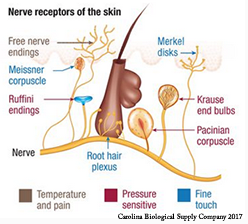
- Epidermis, the top visible layer is .6 mm (eye lid) - 2 mm (hand palm) composed of flat scale like squamous epithelial tissue made from four kinds of cells (Keratinocytes produce keratin, a protein that hardens and waterproofs the skin and produces antibodies and enzymes for protection. Melanocytes produce melanin, a pigment that protects cells from ultraviolet radiation. Langerhans cells are star shaped macrophage phagocytic cells that interact with white blood cells as an an immune response for foreign proteins. Merkel cells are hemisphere shaped that form nerve endings for sensing. in four or five layers (palm & sole).
- Hair protects the skin from UV radiation, dust and other particles (eye lashes, eye brows, nose hairs), and helps maintain body heat. Hair is made of dead keratin cells and consists of a bulb, root and shaft that grows in a follicle. A muscle (arrector pili) connects to each muscle to involuntarily make hairs stand up. Each hair has three concentric layers:
- Central core (medulla)
- Several layers of flattened cells (cortex)
- Outer layer (cuticle) of single cells that overlap like shingles that give strength.
- Living cells in the epidermis make a new hair, however, the external part of the hair is dead cells. There are about 5 million hair follicles on an adult body with men having a few 100 000 more than women. The shape of a hair follicle determines if it is curly, wavy, or straight. Round or oval. The flatter the oval the more curly the hair. The more round, the straighter. Color of hair is determined by a pigment melanin in the cortex. There are three basic types of melanin: eumelanin, pheomelanin, and neuromelanin. Eumelanin, gives people black or brown hair and pheomelanin, gives people red hair.
- Hair is the best texture to reduce heat gain from solar radiation, with tight curled hair being the most protective. Baldness increases heat loss through evaporation compared to hair, but increases the risk of dehydration due to water loss.
- Sweat is 99% water which evaporates from the skin's surface and cools it. Sweat is produced in two types of glands: eccrine and apocrine. when they receive signals from the SNS (sympathetic nervous system). Signals sent when the body or environment is hot or when aroused by stress or fear sweat is produced in these glands (eccrine and apocrine). Eccrine glands are all over the surface of the body and are extremely sensitive to SNS signals. Apocrine glands are in the arm pits and perianal area. Eccrine sweat is mostly water and salt (NaCl). However, it also includes dermcidin, an antibiotic peptide that effects bacteria growth and may fight infection. Apocrine sweat is associated with hair follicles and comes from cells deeper in the body. It can include body oils that become smelly when acted on by bacteria. However, apocrine glands produce less sweat, but is spread across the body by the greater production of sweat in the eccrine glands. Men sweat two times the amount of women. The amount of sweat decreases with age. Hematohidrosis is when blood vessels rupture and flow into the sweat glands to literally sweat blood. Sweat has been orange, blue, and other colors. Causes unknown or related to drugs taken. Smell of sweat can be differentiated between meat eaters and non meat eaters and people who are scared or not. Sweat can also smell differently when people are ill. However, each person's sweat is a unique blend of 373 volatile compounds which is consistent over time from person to person. Cystic fibrosis can be diagnosed by testing sweat.
The amount of sweat present in and on the skin changes how the skin conducts electricity EDA (electrodermal activity) which is used as a measure of stress in a lie-detector test by putting sensors on finger tips and palm. - Sebaceous glands produce oil (sebum) which is secreted into hair follicles and keeps skin moist and flexible and hair a shine.
- Skin Color is determined by three pigments: two forms of melanin: eumelanin and pheomelanin and carotene: a yellow pigment most conspicuous in heel calluses and corns in stratum corneum. Melanin is produced by melanocytes but accumulates in keratinocytes in the dermis layers: stratum basale and stratum spinosum. Hemoglobin is a red pigment in red blood cells that give a red color to skin through blood vessels.
- Fingernails and toenails are tightly packed dead cells of keratin. The grow from the stratum corneum. They allow us to pick up and manipulate very small objects and to tear, dig, and scratch. Nails appear pink because of the hemoglobin in the blood vessels in the bed below.
 Image source
Image source

Skin Care
- Wash skin twice a day with a mild soap and water. To remove dirt, bacteria (that causes odor), and viruses.
- Avoid touching near your eyes, nose, mouth, cuts, and sores so bacteria, viruses, and harmful chemicals are less likely to enter.
- Wear protective clothing: hats, shirts, pants and use sun screen on exposed skin. Particularly between 10 A.M. and 4 P.M. and remember UV rays are more powerful in higher altitudes.
- Never use tanning beds.
- Acne is caused when pores clog and bacteria creates inflammation and pus. Keep pores clean by washing, not using excessive amounts of cream and make-up and washing make-up off regularly. If acne is serious, medication can be described by a dermatologist.
- Eat a well balanced diet and be sure Vitamin A (retinol) intake is sufficient.
- Body piercing and tattoos cause openings for pathogens. Bacteria, viruses (hepatitis B, hepatitis V, and HIV) can enter with non-sterile needles or while healing with exposure. Particularly vulnerable are piercings that pass through skin, near bone (eyebrow), blood and lymph vessels where disease can spread. Also when they are located in places with high volumes of bacteria (mouth).
- Wound care. Stop any bleeding, cleaning the area, adding an antiseptic, and protecting the area while it heals and another action to help the body's natural defenses (clotting by platelets to stop bleeding and protect the healing process, and inflammation and immune function: Surround an infection or wound with fluid and materials to contain the problem, kill any pathogen, remove dead tissue and foreign materials.
Skin system health related issues
- Other skin problems include: warts, cold soures (viruses) that are spread by contact. Fungal infections (athlete's foot, ringworm) spread by contact with public showers and clothes. Boils (infected hair follicles) spread by squeezing.
- Moles are mostly harmless a few develop into melanoma (skin cancer).
- Vetiligo (patches of skin do not have melanin) and are extremely sensitive to UV burning.
- Dermatitis or eczema are inflamed scaly itchy skin caused by allergic reactions. They can be treated with moisturizers, anti-inflammatory drugs, and other medication prescribed by a dermatologist.
- Cuts, wounds, bruises, pressure sores, blisters, sunburn, callusus, corns.
- Acne is a disorder that affects the skin's oil glands and hair follicles. Oil and skin tissue is produced faster than can be removed from the skin pores. Hormones, stress, diet, bacteria, and medications can affect acne. Treatment can include: medication to reduce oil production, speed up skin cell turnover, fight bacterial infection or reduce inflammation. Consult a dermatologist. Source
- Rosacea visible blood vessels cause redness, swelling, and breakouts usually on the face. Currently unknown causes and treatment.
- Itching is an unpleasant sensation that makes you want to scratch. Special cells in your spinal cord only send signals for itching. So, it's different from other feelings. When you scratch an itch, your brain releases serotonin, which makes you feel good, but it also sends another itch signal, starting another cycle. This cycle can keep going until you start to feel pain and think scratching might not be good for you, and you stop. If you've scratched long enough, inflammation results and your body might start an immune response to fight off the itch by releasing chemicals like histamine. If this keeps happening, it can become a problem. Most itches go away on their own, but they can become chronic and make you feel uncomfortable and unhappy. Itching is like your body's way of telling you to stay away from things like poison ivy, mosquitoes that carry diseases, and other trouble.
Dehydration, heat exhaustion and heat stroke
Dehydration, heat exhaustion and heat stroke relates to the skin and the ability for it to regulate temperataure through sweat. However, the heart, blood vessels, brain, nervous system, and cells combine to achieve this regulation. To avoid heat related injuries a person must remain hydrated and not let their internal temperature increase much above normal. However, you can not drink yourself out of a heat related injury.
- Dehydration is a harmful reduction of water. When a person is thirsty, they need to drink to keep from getting dehydrated. However, people can quench their thirst before they are hydrated and they can often be motivated to continue to work or compete in unsafe environments. Not being thirsty does, not mean a person is not dehydrated. When dehydrated, the heart rate will increase as the body tries to move more blood to the surface to cool it. If the outside temperature or internal temperature is too high, the body temperature will continue to rise. When this happens there is heat exhaustion.
- Heat exhaustion is recognized with cramps, fatigue, headache, nausea, and dizziness. People must move out of the heat, stop exercising, and cool down. A fan, a splash of water, or cold compresses on the skin can be helpful in the early stages. (104 degree body temperature) and in later stages (above 104 degree) a cool bath may lower the body temperature to normal, if done early enough. If the body isn't cooled and continues to get hot it will dehydrate enough to stop sweating and cause heat stroke.
- Heat stroke can cause the brain to malfunction and cause confusion, agitation, slurred speech, and even lose consciousness and fall into a coma. Blood vessels can be damaged, clot, and cell proteins break down.
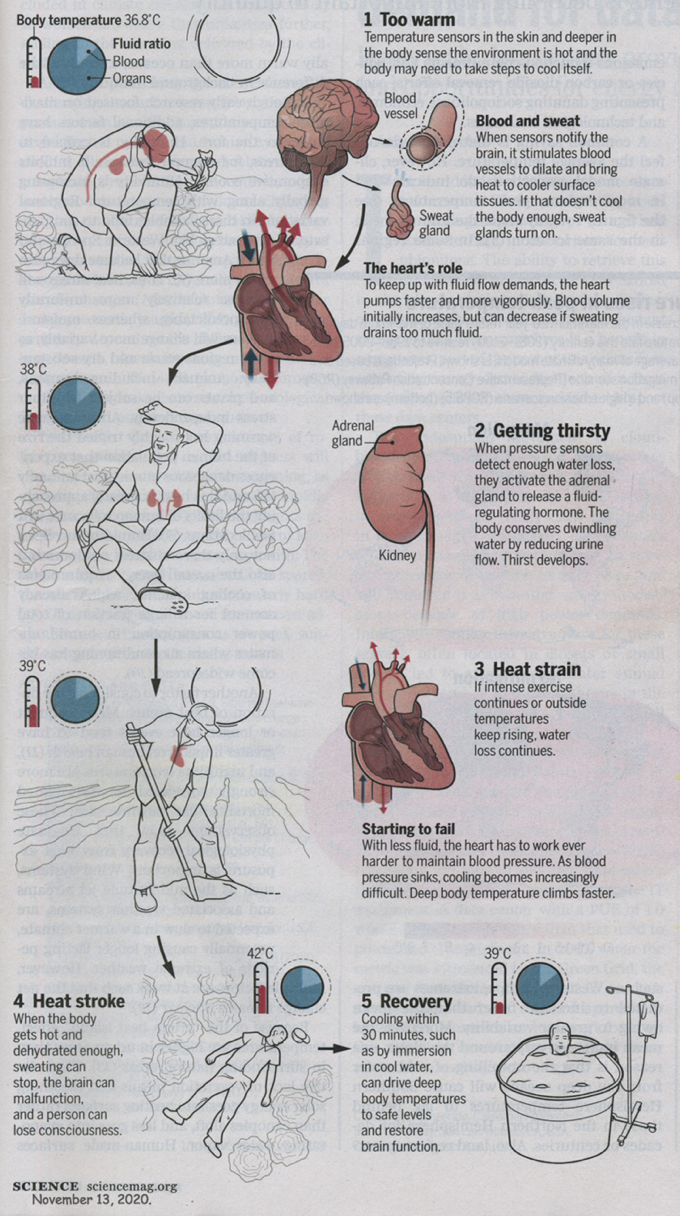
Hair care
- Brushing hair removes dust and evenly distributes natural oils.
- Good nutrition is essential for healthy hair particularly protein.
- Excessive heat (curling irons...) harsh chemicals (dyes, bleach, sprays ...) can make hair thin, brittle, and dry.
- Head lice are tiny parasitic insects spread by head to head contact or sharing brushes, combs, or hats. Treatment and more information.
Nail care
- Nail care includes cleaning and trimming nails so they are level above the skin and cuticles are kept pushed back. Toenails should be cut straight across. Avoid cuts or breaks in the nail or near the nails as this can allow pathogens to enter and cause an infection. Care for cuts or breaks as you would any wound by cleaning and using an antiseptic.
Skeletal system data sheet Review
Skeletal system: Includes 206 bones, which are living tissues and connective tissues: ligaments that attach bone to bone; cartilage that cushion bones from shock and friction, add structure to noses, ears, and larynx; and tendons that attach muscle to bone. All bones begin as cartilage in the embryo and harden through a process of ossification (Os in Latin means bone). The tiniest bones are three in the middle ear collectively called the ossicles (malleus, incus, and stapes) and the largest bone is the femur (thigh bone).
Bones:
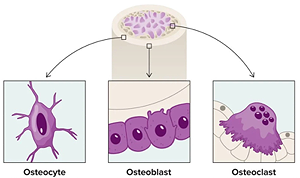
Bones are made with three unique tissue:
- Osteoblasts are bone builders
- Osteoclasts are recyclers
A balance between the two actions (building bone and recycling bone) keeps the bones healthy. When there is an imbalance, bone diseases can happen. This bone cell communication was pioneered by: Lynda Bonewald - Osteocytes sense mechanical load and stress to determine a healthy response. They also communicate with the brain, kidneys, pancreas, fat, muscles, and microbiota. Examples of how they communicate include: a growth factor called FGF23, a hormone leptin, proteins osteocalcin (regualte blood sugar) and myostatin (regulat bone mass), and microbiomes in the gut. Osteocytes make prostaglandin E2, when muscles experience stress, which promotes muscle growth.
- Muscles also communicate with bones to keep both healthy. Muscles make beta-aminoisobutyric acid (BAIBA) that influences fat and insulin responses during an increased use of energy. It also protect osteocytes from dangerous byproducts of cellular metabolism and keeps both bones and muscle healthy. Muscles also make, irisin, which is necessary for healthy osteocytes and promotes bone remodeling.
Source
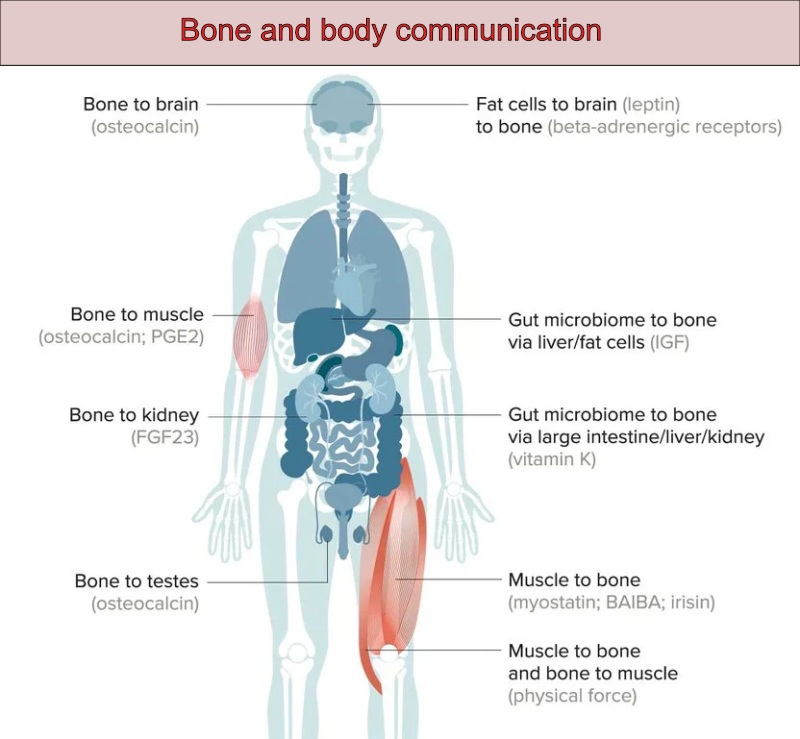
The skeletal system
- Supports the body and protects its internal tissues and organs from damage
- Gives the body shape
- Provides structure for the body
- Provides a frame for the body to attach bones and muscles so they can interact for movement
- Produces hundreds of billions of red and white blood cells (Leukocytes) in the spongy interior, (marrow). They transport oxygen, fight infections, clot blood at wounds, and make up cartilage and fat.
- Stores fat and minerals (calcium and phosphorus).
Joints are where bones meet. Some joints are fixed (skull, rib, ...) and some are movable (synovial). Movable (synovial) include: Source
- Ball and socket joint (shoulder and hip),
- Ellipsoidal (condyloid) joint (back and forth and side to side movement in the metacarpals and phalanges),
- Hinge joint (fingers, ankle, elbow, knee),
- Saddle joint (thumb),
- Gliding joints (carpals in the wrist and tarsals in the ankle),
- Pivot joint (C1 & C2 vertebrae where the head moves left and right).
Skeletal system care
- Good nutrition particularly foods with calcium, vitamin D, and phosphorus.
- Weight bearing exercise (weight training, walking, jogging, ...)
- Wearing protective gear (shin guards, knee guards, elbow guards, helmets, and pads).
Skeletal system health related issues
- Fracture is a break in a bone. Different types of fractures include:
- Hairline fracture is when the broken parts do not separate.
- Transverse fracture is completely across the bone.
- Comminuted fracture is when the broken parts include more than two pieces.
- Compound fracture is when the bone is exposed through the skin.
- Sprain is a stretched or torn ligament caused by falling, twisting, or getting hit. Most sprains are to the ankle and wrist. Symptoms include pain, swelling, bruising, being unable to move, and hearing a pop or tear when injured.
- Scoliosis is curvature of the spine. Can be front to back (lateral) or side to side.
- Dislocation is when the bone slips from the socket tearing ligaments that attach the bone at the joint. Doctor will reset the bone and immobilize it till the ligaments heal.
- Torn cartilage may require arthroscopic surgery to remove and repair the damage.
- Arthritis is an inflammation of the joint from normal wear, injury, or autoimmune disease.
- Bursitis is pain in the joints caused by inflammation of the fluid between the bones at a joint.
- Bunion is swelling between the toe joints. Caused by inflammation of the fluid between the joints from poor fitting shoes.
- Repetitive motion injury, such as carpal tunnel syndrome, is caused by damage to the ligaments and tendons from factory work, computer use or other prolonged movements. Can result in swelling, numbness, weakness, tingling sensation and pain.
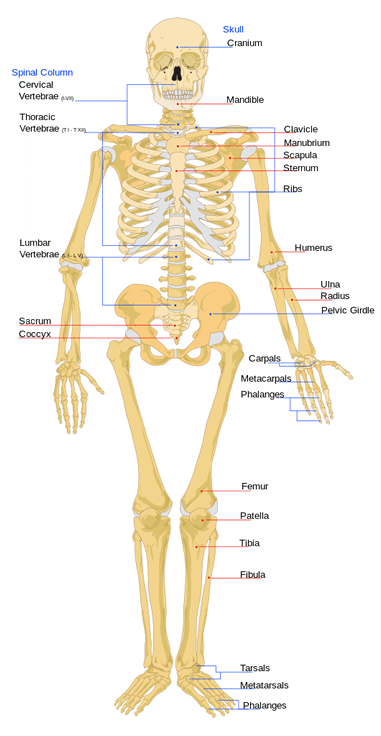
Adapted from Lady of Hats, Mariana Ruiz Villarreal [Public domain], via Wikimedia Commons
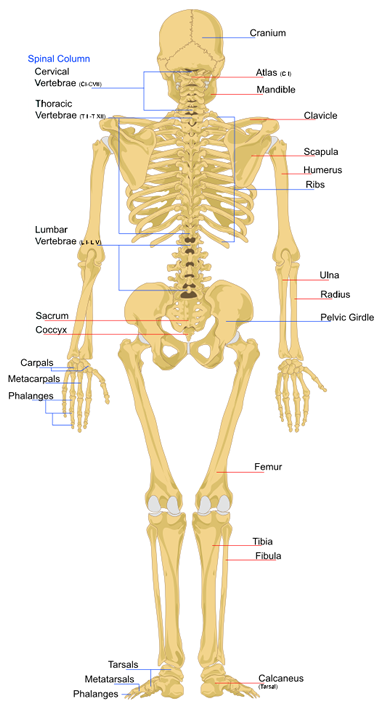
Adapted from LadyofHats, Mariana Ruiz Villarreal [Public domain], via Wikimedia Commons
Muscle system data sheet Review
Muscular system: Muscles enable the body to move, voluntarily (aware: walk, move ... ) and involuntarily (unaware: heart beat, digest food, breathe ... ), offers protection, and gives the body form and shape.
Types of muscles:
- Smooth are involuntary muscles that line hollow spaces in internal organs (digestive tract, urinary tract, bladder, blood vessels, lungs ... )
- Skeletal muscles attach to ligaments and tendons for body movement. To move, muscles work together in opposition as each muscle can both expand (relax) and contract. Muscles that open a joint, extensor (triceps) and muscle that close a joint, flexor (biceps) both expand and contract. Once when opening, bicep expands to an open arm and contracts to close and triceps expands when closing and contracts when the arm opens.
- Cardiac muscles are involuntary muscles that form the walls of the heart. The heart contracts to pump blood to all parts of the body through the circulatory system about 100 000 times a day.
Muscular system care
- Regular physical exercise with weight movement to keep muscles strong and toned.
- Balanced diet with sufficient protein to build muscle.
- Good posture to strength muscles and enhance body structure
- Use equipment appropriately and safely
- Use protective gear and equipment
- Warm up and cool down properly to prevent strain ...
Muscular system health related issues
- Bruises are caused by leaks and breaks of injured blood vessels. The leaks cause the discoloring of skin and can be treated with ice to reduce initial swelling.
- Muscle strain and sprain can be caused when muscles stretch or are partially torn with stress. Apply ice to reduce swelling and rest to repair the muscles.
- Tendinitis or inflammation of a tendon can be caused by overuse, injury, or aging. Anti-inflammation medicine and ultrasound can reduce pain and swelling.
- Hernia is when an organ or tissue protrudes through the muscle area. Caused by strain (maybe lifting heavy objects). Surgery may be required to repair the area.
- Muscular dystrophy is when muscle tissue is progressively destroyed. No cure, but can be delayed with physical therapy.
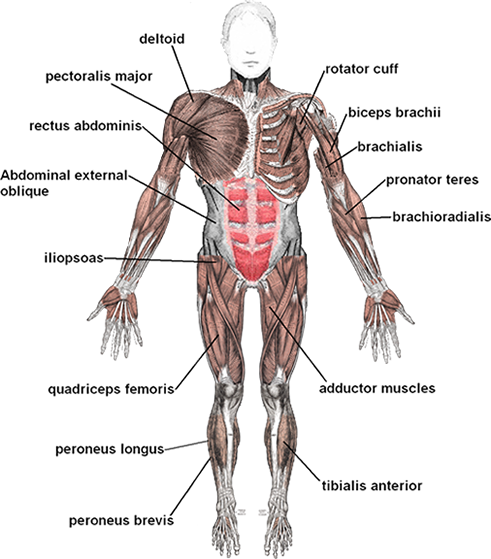
Diagram adapted from Medical gallery of Mikael Haggstromm 2014 [Public domain], via Wikimedia Commons
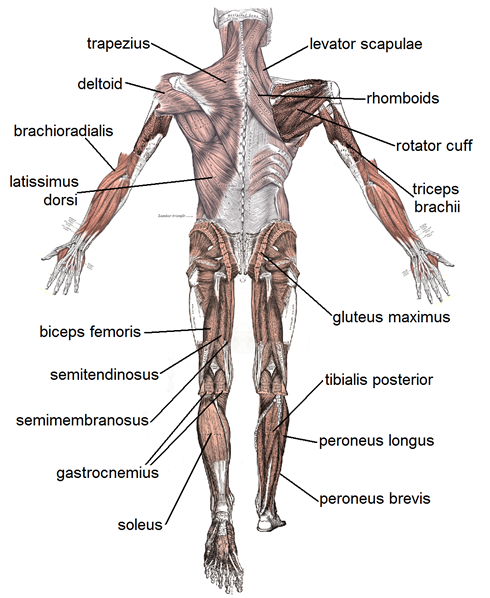
Diagram adapted from Medical gallery of Mikael Haggstromm 2014 [Public domain], via Wikimedia Commons
See also Difference between human and chimpanzee musculature and upright walking.
Nervous system data sheet Review
Nervous system includes the brain, spinal cord, and all the nerves in the body. It coordinates all the bodies activities. The brain receives internal and external messages from nerves that sense changes of touch, electrical signals, hormones, and chemicals. Nerves sense changes of touch, electrical signals, hormones, and chemicals. The messages travel through the nervous system where they are processed, mostly in the brain, which sends information to muscles and glands that cause physical actions. Some information may be processed and stored as memory.
The nervous system is classified in the following way:
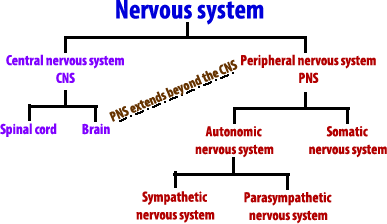
The nervous system includes the central nervous system (CNS) which includes the brain and spinal cord.
It also includes the peripheral nervous system (PNS) which includes all the nerves and sensory receptors that extend from the brain and the spinal cord. The CNS receives information from the PNS, interprets it and sends a response back to the PNS.
The peripheral nervous system (PNS) includes the autonomic nervous system (involuntary or semi voluntary) that regulates and controls functions of internal organs (heart, lungs, stomach intestine...), and glands. Most of the time people are unaware of the autonomous nervous system as it works involuntary with reflexive actions (move food through the digestive system, regulate the heart beat, dilate blood vessels, pupils of the eyes, breathing rate ...)
Subcategories of the PNS autonomous nervous system are the
- Sympathetic nervous system mobilizes the body resources as a fight or flight response that includes dilating pupils for better vision, reducing saliva to save energy for emergency use, increase heart rate, dilate blood vessels for greater blood flow, relax the airways for greater air flow, reduce digestion to increase energy use elsewhere, release glucose for energy, secrete epinephrine and norepinephrine for greater awareness, relax the bladder, and increase blood flow to sex organs.
- Parasympathetic nervous system during periods of rest mobilizes body resources to replenish the body by slowing heart rate, relaxes blood vessels, lowers blood pressure, repairs the body by releasing glucose, stimulates production of saliva and stomach secretions to promote digestion and absorption, constricts pupils to relax observation, slows respiration, constricts the bladder, and promotes sexual arousal. See also stress response and stress management.
The peripheral nervous system (PNS) also includes the Somatic nervous system. Somatic (voluntary) sends signals with information related to vision, sound, smell, taste, touch, temperature, and pressure from the sensory organs (eyes, ears, nose, tongue, & skin), sensory maps of the body, voluntary muscle signals, emotions, memory and consciousness functions to the CNS which returns command signals to the muscles for voluntary movements through the PNS.
Interception & Exteroception are similar and sometimes used more broadly to explain how our senses relate to the decisions we make.
Interception is the ability to precisely sense the body's internal states in a timely manner. Our bodies temperature, hunger, thirst, emotional needs ...
Exteroception is the ability to sense stimuli that are external to us. Our environment and the things in it including weather.
Both are equally important for our survival and physiological well being.
Our interoceptive system enables us to continuously monitor and map the ever changing landscape within our bodies, maintain physiological homeostasis, provide motivational drivers, and shape our thoughts and emotions.
Disruptions in interceptive signals can lead to a range of physical and psychological disorders, including psychiatric disorders, neurodegenerative disorders, and chronic visceral pain, which can profoundly affect quality of life.
Organs, tissues, and cells of the nervous system
Neurons are cells that process and transmit information as impulses that move through the axon and transmitted with a chemical or electrical signal that passes through a synapse where neurotransmitters (acetylcholine, GABA, adrenaline, dopamine, serotonin, glutamate, and endorphins) affect how signals are relayed to another neuron, muscle cell, or gland cell. See neuron growth and pruning video (1:56).
- Sensory neurons transmit messages from the receptors in the body (skin, muscles) to the CNS (brain and spinal cord). The information is processed as pressure, pain, tickles...
- Motor neurons transmit a response from the brain and spinal cord (CNS) as messages to the muscles (to contract and cause movement) and glands.
- Autonomic neurons transmit signals that have an involuntary or semi-voluntary functions that control the heart rate, blood pressure, digestion, temperature regulation, sweating ... See heat related injuries
- Interneurons are located in the CNS and connect neurons in the brain and spinal cord. They transmit messages among the CNS.
Interneurons receive information from sensory neurons and transmit it to the brain where it is processed. Touching a hot stove causes a sensory neuron to send a signal to the brain where it is transmitted through interneurons. The interneurons process information from the sensory neurons, and send a signal to motor neurons in the hand and the hand pulls back from the stove (involuntary reflex, an automatic and nearly instantaneous movement in response to a stimulus. Automatic muscle response may be first processed in the spinal cord and later in the cerebrum causing a faster reaction time.
The brain can process information itself through interneurons and send a signal to motor neurons. For example, the brain decides it is time to get up or roll over and go back to sleep, and signals the body to do so.
Neurons have three main parts
- Cell body connects to the dendrites, and axons, contains the nucleus that regulates the production of protein.
- Dendrites that grow from the cell body and receives impulses that can be excitatory (increase action) or inhibitory (decrease action) and transmit them to the cell body.
- Axons also grow from the cell body and toward neurons, muscle cells, or glands and transmit impulses to them.
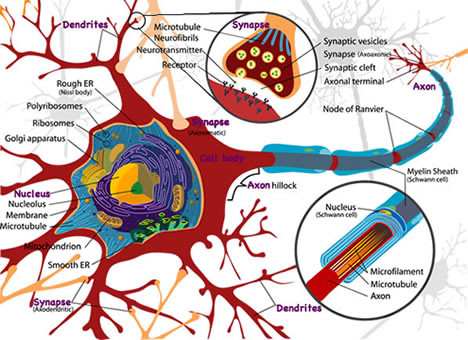
Adapted from LadyofHats [Public domain], via Wikimedia Commons
Spinal cord is part of the the central nervous system (CNS) that transmits electrical signals. It is made of nerve tissue and is about as thick as an index finger. It is surrounded by spinal fluid, connective tissue (spinal meninges) and vertebrae (bones) that all protect it.
Brain
The brain receives, processes, and sends signals. It is surrounded by four layers of cranial meninges, cerebrospinal fluid (CSF), and the skull (bone). The glymphatic pathway transports the CSF, which includes proteins and wastes, along with wastes from the lymph system. These wastes are transported, when asleep with cardiac rhythm, into the dura, absorbed by the meningeal lymphatic vessels, and from there into the brain draining cervical lymph nodes and then transported in veins to the liver where they are removed and recycled. An adult brain weighs about three pounds. It has three main areas from the top to the bottom: cerebrum, cerebellum and brain stem. (For more see Science July 26, 2024. The anatomy of brainwashing. by Jonathan Kipnis.)
The cerebrum is the newest evolved and is the center of conscious thought, learning, and memory. It includes:
- Frontal lobe that controls voluntary movement, language, concentration, cognition, memory, analysis, consequences, critical thinking, problem solving, logic, planning, and emotions.
- Parietal lobe integrates information from the senses (hot, cold, pain, touch, and body position in space) for spatial, visual, speech, pain, and touch responses.
- Occipital lobe is the sight and visual processing center and place for dreams.
- Temporal lobe is the hearing and auditory processing, smell, memory, thought, and judgment. It is the location of the hippocampus which is associated with memory and memory of faces and locations and sends those memories to be stored in areas of the cerebrum. It then recalls those memories later.
- Cerebellum receives information from the somatic nervous system (PNS), the spinal cord, and other parts of the brain to regulate voluntary movement such as posture, balance, coordination, speech, to achieve a smooth and balanced activity.
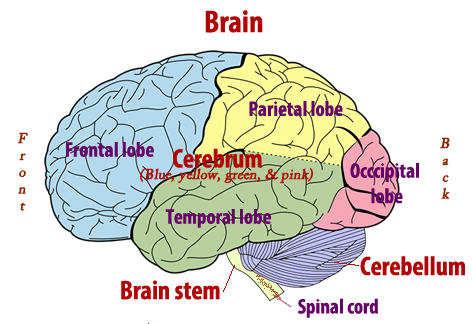
Adapted from Henry Vandyke Carter [Public domain], via Wikimedia Commons
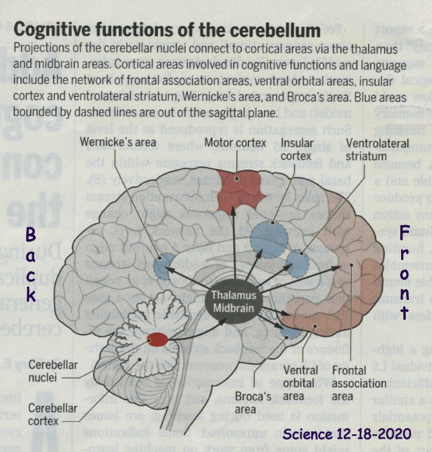
The brain stem is the oldest part of the brain. It is about three inches long and is a bundle of nerve cells that connect the brain and the spinal cord. All incoming sensory impulses and motor impulses pass through the brain stem. It includes:
- Medulla oblongata regulates the heartbeat, respiration rate, and reflexes (coughing, sneezing).
- Pons regulates breathing and coordinates the eyes and face muscles.
- Midbrain controls the eye movement, pupil dilation, and reflex response for head turning.
- Thalamus transmits sensory impulses from the eyes, ears, and pressure on the skin.
- Hypothalamus regulates body temperature (see heat related injuries), appetite, sleep, and secretions of the pituitary gland that affects metabolism, sexual development, and emotions. In addition to regulation by nerve and hormone signals, fragments of bacteria from the gut act as signals that are also used for regulation as illustrated below.
- Reticular activating system (RAS) is the connected neurons in the brainstem that regulate attention, arousal, modulation of muscle tone, the ability to focus, and sleep - wake transitions.
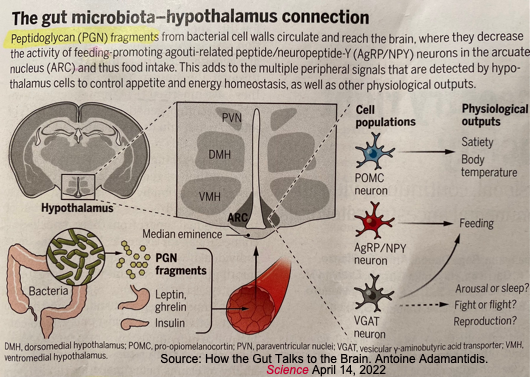
The mind is not the brain, but what the brain knows or does.
Nervous system care
- Good nutrition
- Exercise
- Sleep - More on sleep or read Snoozefest: The Surprising Science of Sleep
- Protective equipment (helmets...) and devices (seat belts...)
- Avoid use of drugs and alcohol.
Nervous system health related issues
- Cerebral palsy is a group of neurological disorders caused by damage of the brain before, during, or shortly after birth. Physical therapy and medication can help for a better life.
- Degenerative diseases (multiple sclerosis, Parkinson's disease, & Alzheimer's). Some degenerative diseases are thought caused when the glymphatic pathway is unable to remove protein waste from the brains cerebrospinal fluid (CSF). Cardiac rhythm, fluid and sleep are essential for the this function, as the flow seems to stop when awake. Source Science. Glymphatic failure as a final common pathway to dementia. October 2, 2020
- Eating disorders. Hunger activates brain responses that motivate eating. However, people with anorexia, bulimia nervosa, and other eating disorders brain circuits are less active after fasting. Their brains could identify being hungry, but their brain did not signal a desire to eat.
- Epilepsy is characterized by recurrent seizures caused by uncontrolled electrical activity in the brain. Caused by congenital brain damage, infection (encephalitis), head injury (tramtic & stroke), toxins, genetics (more than 100 genes have been identified), and some unknown.
- Headaches are caused by muscle tension, eyestrain, fumes, sinus infection, dehydration, poor posture, anxiety, noise, alcohol abuse, and food allergies. Migraines are headaches that recur and are associated with neuroinflammation in multiple brain regions and neurotransmitters which causes a wide variety of symptoms. Some causes are foods (aged cheeses, salty foods, food additives, processed foods & drinks may trigger migraines), stress, sensory stimuli to light, changes in wake-sleep pattern, physical factors, hormonal changes in women. (change in estrogen amount seem to trigger headaches in women with known migraines). Preventable measures include lifestyle changes, medication, and electromagnetic devices.
- Head injury concussion which is a temporary loss of consciousness, bruising which causes blood to pool and swelling, swelling, coma, major trauma.
- Mental disorders are illnesses of the mind that affect the thoughts, feelings, and behaviors of people and prevents them from leading happy, healthful, and productive lives. Also mental emotional health
- Mental health is a state of emotional well-being that enables a person to set and achieve their personal goals based on their personal needs for survival and health, like Maslow's Hierarchy of Needs. To be able to cope with stress, meet challenges, solve problems, and contribute to society in an environmentally healthy way.
- Mood disorders are illness with emotional extremes that interfere with everyday life. They include depression, bipolar, or manic-depressive.
- Meningitis is an inflammation of the spinal or cranial meninges caused by bacteria or virus infection. Is very serious and can cause death.
- Multiple sclerosis (MS) is an inflammatory and degenerative disease of the central nervous system (CNS) often in young adults. The Epstein-Barr virus is the trigger for MS through genetic dysfunction. Dysfunction related to 32 associations of the major histocompatibility complex (MHC) genome, 1 to the X chromosome, 200 to the autosomal non-MHC genome. Multiple sclerosis genomic map implicates peripheral immune cells and microglia in susceptibility Science 9, 27, 2019.
- Spinal injuries can be swelling and temporary loss of nerve function. Spinal cord severed results in paralysis.
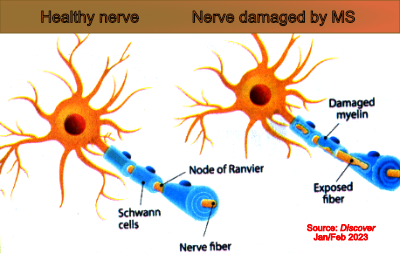
Circulatory or cardiovascular system data sheet Review
Cardiovascular system: Includes the heart, blood vessels, and substances they transport through the body. The heart circulates blood 24 hours a day to and from the cells through the arteries, veins, and capillaries. The blood transports gases, nutrients, waste products, white blood cells (leukocyte cells), hormones, and chemicals as a response to the bodies need.
- Transfers oxygen from the lungs to the body.
- Transfers carbon dioxide from cells to the lungs where it is exhaled.
- Transfers nutrients from food to organs and cells.
- Transfers solid waste products (salt, nitrogen) to the kidneys for removal.
- Transports white blood cells (leukocyte cells), hormones, to maintain body health.
Heart
Heart is an organ made of involuntary striated cardiac muscle that pumps blood. It has four chambers and valves. The top chambers are atria. The bottom chambers are ventricles. The wall tissues are called septum. The valves (tricuspid valve, pulmonary valve, mitral valve and aortic valve) are at the entrance and exit of the chambers. The sinoatrial (SA) node (pacemaker) at the top of the atrium sends electrical impulses to the atria causing it to contract and send additional electrical signals through the heart. See video of electrical flow in heart as it relates to pumping action and monitoring with an EKG (2:00). The contractions squeeze the blood from one chamber to another or to the lungs or body.
See video of an explanation of how the heart circulates blood video (3:29).
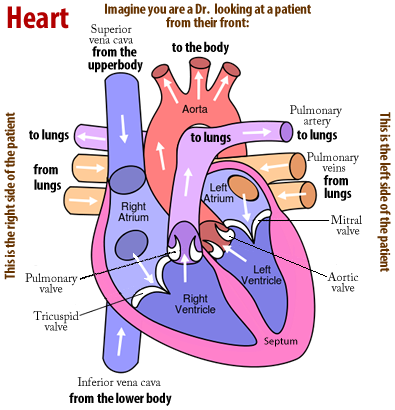 Adapted from [GFDL or CC-BY-SA-3.0], via Wikimedia Commons
Adapted from [GFDL or CC-BY-SA-3.0], via Wikimedia Commons
Blood loop:
body -> right atrium -> right ventricle -> lungs -> left atrium -> left ventricle -> body
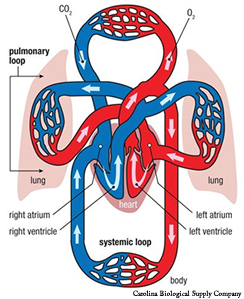
Blood vessels
Blood vessels stretch 60 000 miles (around the Earth 2 1/2 times. There are three types: arteries, veins, and capillaries.
- Arteries are vessels that carry blood away from the heart. They branch into smaller and smaller branches until branching into the smallest branches, capillaries.
- Capillaries are the smallest blood vessels that connect the arteries and veins. Capillaries near the skin can dilate to regulate heat flow from the body.
- Veins are vessels that return blood to the heart. Many veins have valves to prevent the back flow of blood.
Blood is always red. Oxygen-rich blood is bright red as it leaves the lungs. Some people believe that blood without oxygen is blue. They may have believed this because veins appear blue. However, blood is NOT blue! This myth may continue today as many diagrams use red for arteries and blue for veins and people confuse the term blue blood as meaning an aristocrat, noble, or member of a socially prominent family, as having a literal definition.
Most arteries carry oxygenated blood from the heart and most veins carry blood with carbon dioxide to the heart. The exceptions are the Pulmonary artery, going to the lungs, and the Pulmonary vein, coming from the lungs. See diagrams.
Pulmonary artery transports deoxygenated blood from the heart to the lungs. It is one of a few arteries (umbilical arteries in the fetus) that transports deoxygenated blood.
Pulmonary veins transport oxygenated blood from the lungs to the left atrium. There are four pulmonary veins, two from each lung.
Vena cavas transport deoxygenated blood into the heart. There are two in humans, the inferior vena cava (transports blood from the lower body) and the superior vena cava (transports blood from the head, arms, and upper body).
Arteries
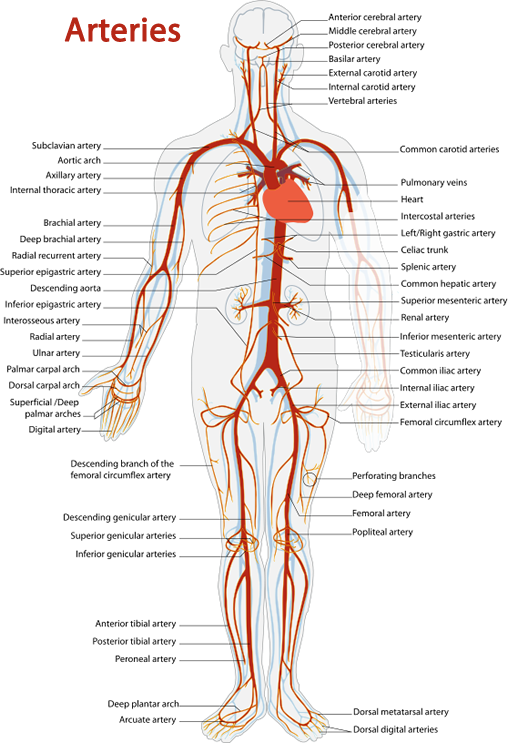
Adapted from LadyofHats, Mariana Ruiz Villarreal [Public domain], via Wikimedia Commons
Veins
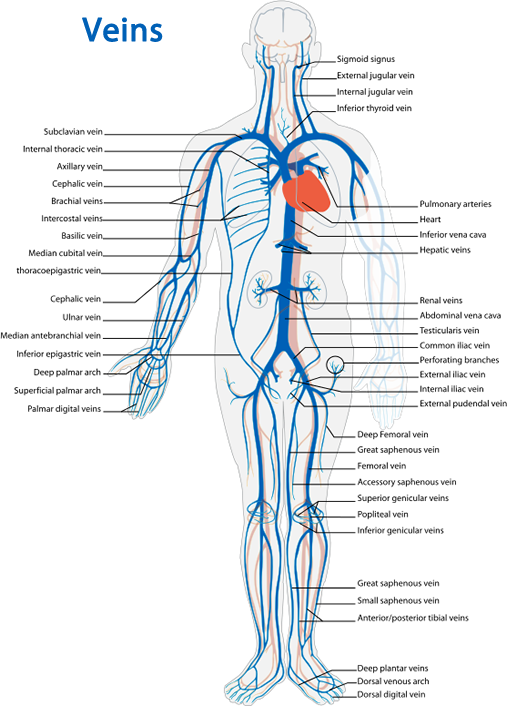
Adapted from LadyofHats, Mariana Ruiz Villarreal [Public domain], via Wikimedia Commons
Blood
Blood is the red liquid in the arteries and veins of humans and other vertebrate animals. The human body has about 5 liters of blood. It carries nutrients, oxygen, and other substances to the cells of the body and removes waste materials and carbon dioxide from them.
Plasma is the fluid in which other parts of the blood are suspended. Mainly water with nutrients, proteins, salts, hormones, red and white blood cells (leukocyte cells). It makes up about 55% of the blood.
Red blood cells have hemoglobin, which is composed of four proteins around an iron molecule. Hemoglobin binds with oxygen and carbon dioxide so they can be transported around the body. Reduced red blood cells cause anemia. Red blood cells make up about 40% of the blood. They also have an immune function. They collect harmful DNA that floats into the blood stream from the body's cells. During an infection or after an injury they can sacrifice themselves to encourage macrophages to eat them, triggering inflammation, which signals the immune system.
Hemoglobin image adapted from Yikrazuul (Own work) [Public domain], via Wikimedia Commons
Platelets are pieces of cytoplasm that originate from megakaryocytes in the bone marrow and enter the blood. Platelets help wounds heal and stop bleeding by forming blood clots and scabs. Problems can result when a person has too few or too many platelets, or when they do not work properly.
Leukocyte cells (known also as white blood cells) surround and ingest foreign matter and organisms that cause disease. They also produce antibodies that provide continued protection for disease that might recur. Leukocyte cells react to allergic reactions. See also Lymphatic and Immune systems
Neutrophils, Basophils, Eosinophils, Monocytes, Macrophages, and Lymphocytes
- Neutrophils are the first defenders against microbe infection. Most often bacterial or fungal infection.
- Basophils help with blood flow and prevent coagulation. They circulate in the bloodstream and release heparin (an anti-coagulant that prevents blood cells from clotting too quickly) and histamine released during allergic reactions to increase blood flow. Presence of these two molecules causes other immune system cells to arrive at an infection or inflammation.
- Eosinophils defend against parasitic infections and allergic reactions.
- Monocytes are made in bone marrow and develop into large macrophages in the bloodstream.
- Macrophages are the largest of the leukocyte cells and engulf cell debris, waste, viruses, and harmful bacteria by extending pseudopodia (feet-like extensions) that surround and destroy the microbe by releasing enzymes
- Lymphocytes in the blood are leukocyte cells which are crucial to our immune systems and work primarily with the lymphatic system. There are three main types known as T leukocyte cells (thymus gland), B leukocyte cells, and natural killer cells. Lymphocytes are part of our immune defense. Their purpose is to recognize antigens, produce antibodies, and destroy cells that could damage the body. See also Lymphatic and Immune systems
Blood types
All humans have one of four types of blood (A, B, AB, & O). Blood types A, B, and AB have different antigens and O has no antigens. If a person has a blood transfusion, he or she must receive blood of the same type, with the same antigen, or type O (universal blo0d type) with no antigen. Blood can also have Rh. If it does it is referred to as Rh positive, If it doesn't, then it is called Rh negative.
Blood pressure
Blood pressure is the measure of force on the blood vessel walls. There are two numbers. The first is the maximum pressure when the heart contracts and pushes blood into the arteries and the second number is when the ventricles are relaxed. These numbers are represented like 120/80. The first number is called systolic (Systole from Greek meaning draw together or contraction.) pressure and measures the maximum pressure when the heart contracts and pushes the blood into the arteries increasing the pressure. The second number called diastolic (Diastole from Greek meaning drawing apart) pressure measures the minimum pressure when the heart relaxes and the pressure decreases. A normal pressure is 120/80 and 140/90 is considered high.
Circulatory or cardiovascular system care
- Eat a balanced diet
- Maintain a healthy weight
- Check your blood pressure and if it isn't in the normal range have a medical check up
- Participate in aerobic exercise at least three times a week for 50 minutes raising your heart rate so that you are warm and slightly out of breath for one hundred-fifty minutes a week See more aerobic exercise ideas.
- Avoid tobacco products including second hand smoke
- Avoid illegal drug use
- Get regular medical check ups
- Avoid prolonged high temperature. see heat related injuries
Cardiovascular health related issues
- Anemia is when the blood doesn't carry enough oxygen. May be too few red blood cells, low hemoglobin, or lack of iron. Treatment is usually iron supplements.
- Congenital heart defects are problems present at and before birth. A hole in the heart's septum or a misformed valve. Caused by genetic factors or poor health of the mother during pregnancy. Treatment can be drugs, surgery, and a heart transplant.
- Heart murmur is caused by a hole in the heart or malfunctioning valve. If serious enough, it may require surgery.
- Hemophilia is an inherited disease that causes the blood not to clot. Bruising and uncontrolled bleeding after an injury. Treated with injection of proteins to stimulate clotting.
- Leukemia is a cancer in which there are too many leukocyte cells or they are abnormally formed. This can cause infection, anemia, and bleeding. Treatment is chemotherapy, radiation, and bone marrow transplant.
- Malaria is a disease caused by a parasite that attacks red blood cells and the liver. It is spread by different kinds of mosquitos through bites and from pregnant mothers to their babies during pregnancy. People who get malaria are typically very sick with high fevers, shaking chills, and flu-like illness. It can cause anemia and jaundice (yellow coloring of the skin and eyes) due to loss of red blood cells and one type may cause kidney failure, seizures, mental confusion, coma, and death. Source
- Sickle cell is a disease where the gene that makes hemoglobin, makes sickle-shaped red blood cells instead of round, causing pain and organ damage.
- Varicose veins is caused by valves in veins not closing well enough to prevent back flow of blood.
Respiratory system data sheet Review
Respiratory system: The respiratory system primarily exchanges oxygen and carbon dioxide through the lungs. Oxygen is needed to metabolize food, which provides energy to move muscles, repair cells, feed brains, calm nerves, and clean the body of toxins. Every day, our body needs to remove about seven hundred billion cells which would be toxic if not removed from our system. Breathing plenty of oxygen provides sufficient energy to eliminate these wastes. The body does not store oxygen like it does food and liquid so it must continually provide cells with oxygen and remove carbon dioxide from the oxidation of food, metabolization. The skin and lungs also transfer thermal energy from the body.
Respiration
Air enters the lungs through the nose, mouth, and the trachea when chest muscles contract causing the volume in the lungs to increase so air flows into the nose or mouth where it is filtered with tiny hairs, cilia, to remove dust, bacteria, and viruses; warm it; and moisten it with mucus, produced in the sinuses. It moves on through the the mouth or nose to the pharynx (muscular wall behind the nose and mouth (throat) that connects to the the esophagus), past the epiglottis (tissue that covers the trachea and larynx when swallowing food or water), then down the trachea (windpipe), which is also lined with cilia and mucus to capture more unwanted particles before the air moves into the lungs.
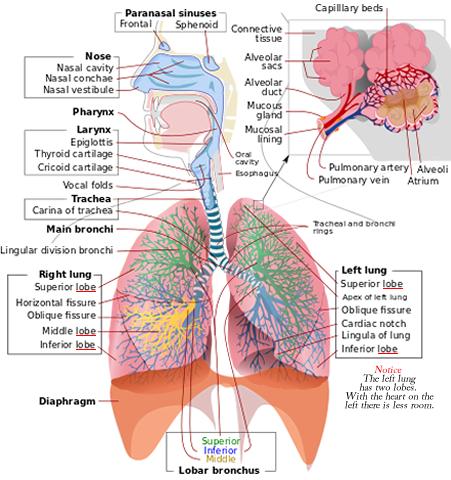
Adapted from LadyofHats [Public domain], via Wikimedia Commons
Air enters the body because the atmospheric pressure outside the body is greater than the pressure in the lungs when the diaphragm contracts and expands the chest volume, thus causing air to flow into them (inhale). When the chest muscles contract the pressure in the lungs is greater than the atmospheric pressure outside the lungs so air flows out (exhale). See lung model construction and demonstration video (3:23)
Also located in the throat area is the larynx, which has vocal cords, two bands of tissue, that vibrate when air passes between them. The vibrations are controlled when air is exhalled and passes between the muscle folds which open and close rapidly compressing and decompressing air to make sound waves. The loudest voice recorded was 129 dBA (decibels). A conversation is about 60 dCB, a rock concert about 128 dCB, and a jackhammer about 100 dCB. At puberty both girls and boys vocal cords lengthen and thicken. As males produce more testosterone their vocal cords become longer and thicker than females.
Inside the lungs oxygen travels through smaller and smaller tubes, bronchi, until it reaches the tiniest air sacs, alveoli. In the alveoli blood is transported through the capillaries and the oxygen from the air attaches to the hemoglobin in the red blood cells.
The oxygenated blood travels from the capillaries, in the lungs, through larger and larger blood vessels to the left side of the heart and then is pumped throughout the body. A network of progressively smaller arteries deliver the oxygenated blood to capillaries and then to the cells, where the oxygen can be used by cells to metabolize food (glucose, fatty acids, proteins) in the mitochondria and provide energy (ATP, NADH ) that powers the cells. In the process carbon dioxide is released. Through another labyrinth of blood vessels, veins, the hemoglobin returns carbon dioxide to the heart and into the lungs where it is released when the body exhales.
Respiratory system care
- Don't smoke and stay away from second hand smoke. Smoke can damage the respiratory system and cause bronchitis, emphysema, asthma, and reduce the growth of the lungs.
- Eat and drink slowly and swallow while not talking so that food doesn't get into the larynx or trachea and cause a choking coughing reaction.
- Wash hands to reduce chances of infection
- Keep hands and other objects away from nose and mouth to reduce infection
- Participate in regular aerobic exercise to increase the bodies ability to use oxygen and improve health in general. See also immunity and exercise
- Avoid air pollution which can cause health problems and cancer.
Respiratory health related issues
- Asthma is the inflammation and contraction of the airways (trachea, bronchi, and bronchioles) that result in difficulty breathing. Acute attacks can be treated with inhaling medication that dilates, expands, airways.
- Bronchitis is inflammation of the bronchi in the lungs. Causes are infections and irritants like smoke, air pollution (house-dust mites, animal danders, pollens, molds, fumes from exhaust, smoke, scents from perfume, deodorants ...). Bronchi produce excessive mucus that blocks the airways, causes shortness of breath, coughing, wheezing, Treatment include antibiotics and avoiding irritants.
- Colds and flu are common infections in the upper respiratory system.
- Emphysema progressively destroys the alveoli in the lungs. Symptoms include difficulty breathing and a chronic cough. Treatment can reduce symptoms, but damage is permanent. Usual cause is smoking.
- Pneumonia is the inflammation of lungs caused by bacterial or viral infection. The alveoli enlarge, clog with mucus, and decrease the exchange of oxygen and carbon dioxide. Symptoms include cough with phlegm, difficulty breathing, tiredness, fever, chills, chest pain, and dehydration. Treatment is with antibiotics.
- Sinusitis is the inflammation of the sinus cavities above the nose and throat. Can be caused by allergies, colds, flu, or other infections. Congestion, fever, stuffiness, headache are common symptoms. Treatment with nasal sprays and antibiotics.
- Tuberculosis is a contagious bacterial infection of the lungs. When infected the immune system attacks and keeps if from spreading. However, if the immune system is weakened the infection can spread and become active. Symptoms when active include coughing, fever, tiredness, and weight loss. Treatment include antibiotics, hospitalization, and rest.
Mucus
The body's submucosal glands and goblet cells make mucus all the time. It's made in the nose, lungs, eyes, digestive tract, and reproductive organs, among other places.
On average, a person makes a lot of mucus each day, about a gallon. It's made up of water, salts, fats, and sugars, all mixed together in a gel called mucin. Scientists sometimes call it a complex multiscale organic mesh.
This mesh traps things, so our mucus can tell us a lot about ourselves. White or clear mucus means we're making healthy mucus. Yellow or green mucus with spots means we have white blood cells, which can be a sign of an infection. Red or scarlet mucus means we have blood in our mucus, and grayish mucus can be a sign of pollution. Source: Discover. You & Your Mucus. by Cutter Wood. July/August 2025.
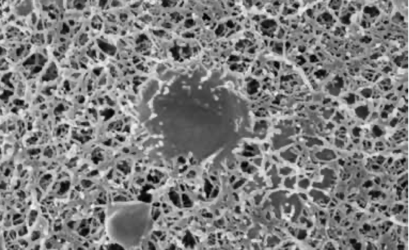
Source Science July/August 2025
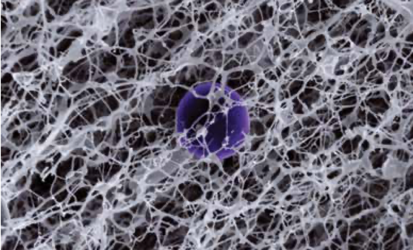
Mucus with microplastic
Source Science July/August 2025
Digestive system data sheet Review
Digestive system includes the mechanical and chemical processes that break down food, into molecules, so it can be absorbed from the digestive tract into the blood stream and distributed to the cells. Major components are the mouth, esophagus, stomach and intestines.
The process starts in the mouth where the teeth rip, tear, and mash food into smaller pieces (mastication) and mix it with the first digestive secretion, saliva. Saliva is produced in the salivary glands and is an enzyme that chemically changes starches and sugars into smaller particles.
The tongue helps the chewing process and forms the food so it can be swallowed. The uvula is tissue at the top back of the mouth that keeps food from entering the nasal cavity. Further down the throat the epiglottis prevents food from entering the respiratory system.
Food is swallowed into the esophagus, a tube made of smooth muscle tissue. It connects to the stomach and moves food to the stomach by peristalsis. Peristalsis is muscle action that squeezes food through the entire digestive tract. At the bottom end of the esophagus food passes through a ring of muscles, esophageal sphincter and into the stomach. The esophageal sphincter prevents acid and stomach contents from traveling back up the esophus from the stomach.
The stomach is surrounded by muscle that expand as the stomach fills. Inside the stomach food is mixed with gastric juices (hydrochloric acid and pepsin, an enzyme that digests protein) secreted from the stomach walls. Hydrochloric acid also kills some bacteria. Mucus is also secreted by the stomach walls and some what protects the stomach wall from gastric juices digesting it. Food is held in the stomach and digested into a fluid, chyme, a mixture of food and digestive juices. Some nutrients are absorbed in the stomach and into the bloodstream (alcohol). Peristalsis moves it past the pyloric sphincter muscle at the bottom of the stomach and into the duodenum, the beginning of the small intestine.
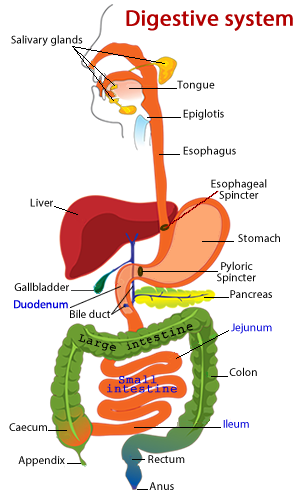
Adapted from Mariana Ruiz Ladyships [Public domain], via Wikimedia Commons
The small intestine is a little over 20 feet long and one inch in diameter. It is where 90% of nutrients are absorbed into the blood stream. It has three areas: duodenum, jejunum, and ileum. Chyme enters the duodenum where it is mixed with more digestive juices. Pancreatic juices secreted are: proteases (trypsin and chymotrypsin) that digests proteins, amylase that digests sugars (carbohydrates), and lipase that digests fat. They exit the pancreas, travel through the bile duct, and enter the duodenum area of the small intestine. The intestine walls make and excrete digestive enzymes, hormones (secretin), mucus, substances to neutralize stomach acid (hydrochloric acid), and erepsin digests polypeptides into amino acids, completing protein digestion.
Enzymes: peptidases digests peptides (which are amino acid chains with a peptide bond see diagram): sucrase digests sucrose (sugar), lactase digests lactose (milk sugar) and maltase (malted foods, sweet potatoes when cooked, digested starches) digests maltose.
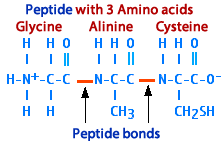
The liver makes bile that breaks down fats for absorption. Bile is made continuously in the liver and stored in the gall bladder until it is need. Then it is is released into the duodenum, the first part of the intestine where most chemical digestion happens. See also liver functions below small intestine information.
The small intestine has projections, villi (one villi is a villus) that are lined with capillaries to absorb nutrients and minerals in food to pass into the blood stream through the intestine walls, mucosa, by diffusion. The mucosa is covered in wrinkles or folds that circle the walls of the intestine. Microscopic fingers of tissue, villi (in Latin it means shaggy hair) increase the surface area for greater absorption of nutrients. Each villus has a network of capillaries and lymphatic vessels called lacteals close to its surface that absorb fat. The epithelial cells of the villi transport nutrients from the inner surface of the intestine (lumen) into the epithelial cells and into capillaries (amino acids and carbohydrates) and lacteals (lipids). The absorbed substances (amino acids, carbohydrates and lipids) are transported via the blood vessels or lymph vessels through out the body to build proteins needed to grow and repair body cells and tissues.
- Crypts are located at the bottom of the villi. They have long lived powerful stem cells (parent cells) which grow all the different kinds of cells that become the villi. These stem cells continuously and rapidly create new epithelial cells (absorptive cells or enterocytes, goblet cells, and enteroendocrine cells) that migrate (move) out of the crypt and up the villus axis to replace the cells that are literally digested every few days.
- Absorptive cells (Enterocytes) are epithelial cells found on the lumen of the small intestine. They contain digestive enzymes and have microvilli on the surface that increase surface area to increase digestion and the amount of molecules absorbed through the intestine into the blood stream.
- Goblet cells make mucus as necessary for digestion and protection of the intestine. The amount and type of mucus is determined by the type of food being digested and immune responses from tuft cells and other sources.
- Enteroendocrine cells are the most numerous cells in the body. They are located in the intestine and pancreas. They have an endocrine function that stimulates chemoreceptors as a result of the digestive process or introduction of harmful substance. Stimulation results in the release of hormones and peptides either into the intestine or into the bloodstream. These hormones and peptides regulate digestion directly in the intestine or through nervous system responses.
- Not exactly part of of our body are microbes that live in the intestines. These microbes (around 38 trillion) out number all the cells (about 30 trillion) in our body. Together they they makeup a person's microbiome (microbial community) and they are important for overall health. What you eat feeds the tiny critters that make up your gut's microbiome. Therefore, a healthy diet is necessary for a healthy microbiome, which can protect against metabolic disorders and inflammation.
Foods for a healthy microbes: include fiber, phenols, fermented foods, and (healthy) fats (The Four F sounds).- Whole grains and beans have fiber. Steel cut oats are especially beneficial.
- Phenols give fruits and vegetables their colors. And to get plenty of these, focus on eating colorful food. Or, eat the rainbow.
- Fermented foods include kimchi, sauerkraut and kefir.
- When it comes to fats, focus on omega-3s. Oils from fruits, such as olive oil and avocado oil. Nuts and fatty fish also contain omega-3 fats. Butter isn't terrible, especially when it's made from milk from grass-fed cows.
Source
More liver. The portal vein carries blood with nutrients (digested food) from the small intestine to the liver where the nutrients and toxins are absorbed, filtered, and detoxified before going back to the heart and lungs and on to the rest of the body. Some of it returning to nourish the liver through the hepatic artery.
All the undigested and unabsorbed materials move through the small intestine to the colon (large intestine). The colon is between 5-6 feet long and about 2.5 inches in diameter. It absorbs water, salts, vitamins, iron, and eliminates the waste (unabsorbed material left). It has no villi.
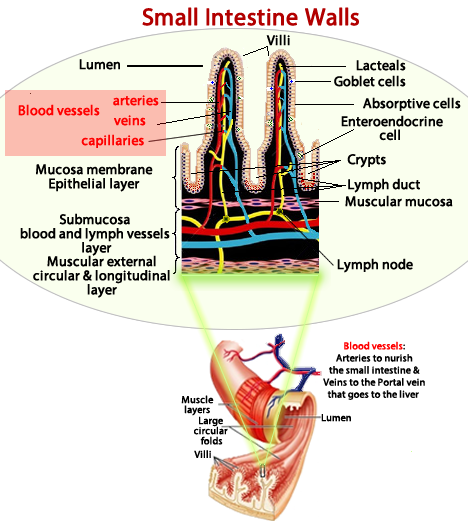
Adapted from Boumphrey [CC BY-SA 3.0 or GFDL], via Wikimedia Commons
Digestion of nutrients for energy
- Carbohydrates are broken down by saliva from the salivary glands, amylase from the pancreas. Maltase from the intestine converts maltose into glucose. Lactase from the intestine converts lactose into glucose and galactose. Sucrase from the intestine converts sucrose into glucose and fructose. These sugars are absorbed in the small intestine.
- Protein breaks down with hydrochloric acid and pepsin secreted by the stomach, proteases (trypsin and chymotrypsin) from the pancreas. Protein is absorbed in the intestine as amino acids.
- Fat breaks down with bile acid from the liver, lipase from the pancreas, and absorbed by the lacteals in the small intestine.
Digestive system care
- Eat slow and chew food well.
- Drink at least 64 ounces of water daily (8-8 ounces or 5 1/2-12 ounces).
- Eat healthy, low fat, high fiber.
- Wash your hands.
- Use safe food preparation and storing techniques (cool, clean, cook, & separate).
- Visit a health professional regularly or as a need may arise.
Digestion health related issues
- Heartburn is a burning discomfort in the upper abdomen, chest, or below the breast bone. The lower esophageal sphincter (LES) opens when belching or to let food move from the esophagus to the stomach and closes to keep stomach acid in the stomach. However, if it opens too often or does not close tightly, stomach acid can reflux, or seep, into the esophagus and cause a burning sensation. Heartburn can be caused by too much food in the stomach (overeating), too much pressure on the stomach (being over weight, pregnant, or constipated) or foods that relax the lower esophageal sphincter (tomatoes, citrus fruits, garlic, onions, chocolate, coffee, alcohol, caffeinated products, and peppermint). Foods with a high percentage of fats and oils and some medications can increase discomfort. Stress and lack of sleep can increase acid production and can cause heartburn. Smoking, both relaxes the sphincter and stimulates stomach acid. Reduce stress, control diet by not eating foods that contribute to increased acid or relaxes the LES. Medication or in serious cases surgery.
- Constipation is when the solid waste (feces) becomes hard and dry making bowel movements difficult. Exercise, drink sufficient water to soften, and eat sufficient fiber to move waste through the digestive system. Consult with medical experts to review the use of medication (antidepressants), vitamin supplements (large doses of calcium, iron), or diet (too much dairy ... not enough fiber) that may be the cause constipation.
- Indigestion is the feeling of discomfort in the upper abdomen sometimes with nausea and gas. Can be caused by eating too much, too fast, too much fat, spicy foods, or stomach disorders or stress. Change eating habits and if problem continues, consult a medical professional.
- Stomach ache and nausea can be caused by gas, motion sickness, bacteria, virus, medication, and dehydration.
- Diarrhea is frequent watery feces. Can be caused by medication, stress, bacteria, virus, lactose intolerance, parasite, or nutritional deficiencies. Dehydration can occur along with it. Drink plenty of fluids and if there is a high fever, sever pain, black or bloody stool, or it persists consult a medical professional.
- Appendicitis is inflammation of the appendix caused by blockage or bacterial, viral, or fungal infection. Symptoms may include dull or sharp pain anywhere in the upper or lower abdomen, back, or rectum, fever, nausea, and vomiting. Consult a medical professional. Lack of timely treatment can result in death if the infection spreads.
Additional resource:
- It Takes Guts: How Your Body Turns Food Into Fuel (and Poop) by Belle Wuthrich and Jennifer Dr. Gardy. 2022.
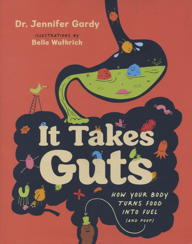
Excretory system data sheet Review
Excretory system eliminates solid, liquid, and gas wastes necessary to sustain life. Undigested food is eliminated as solid waste through the intestinal tract small intestine and colon (see digestive system). Skin removes liquid and heat (see skin system). Lungs rid the body of heat and carbon dioxide, gas (see respiratory system). The urinary system remove liquids and solids (see excretory system) and endocrine removes solid and liquids (see endocrine system).
The liver filters and processes blood as it circulates the body. It receives blood from the small intestine. The liver removes toxins like ammonia, drugs, alcohol, and cellular products like bilirubin that results from breaking down worn out red blood cells. It metabolizes nutrients, detoxifies harmful substances, makes blood clotting proteins, and other vital functions. Cells in the liver have enzymes (proteins that catalyze a biochemical reaction) that regulate its chemical reactions.
The urinary system filters extra water and waste from the blood and eliminates them from the body to maintain fluid balance inside the body. Many of the waste molecules include salt, proteins, and dissolved nitrogen. The system includes kidneys, bladder, ureter, and urethra.
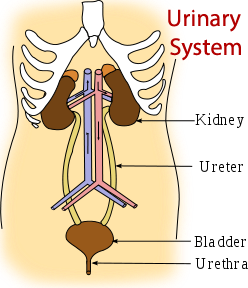
Adapted from Illu_urinary_system.jpg: Arcadian derivative work: Thstehle Derivative work by Commons sibi [CC BY-SA 3.0], via Wikimedia Commons
Kidneys are bean shaped organs in the middle of the back below the rib cage, one on each side of the body. Each is about 4-5 inches from bottom to top; a bit bigger than a fist. Each contains more than a million small spherical shaped containers (nephrons) that the liquid part of the blood and materials smaller than proteins and red blood cells enter. Liquids and materials that enter the chamber (blood lite) flow into other capsules and tubules (glomerulus). Some of the materials (amino acids, salt, water ... ) pass through the walls and are rerouted back into the blood (reabsorbed). Depending on the concentration from one side of the wall to the other the flow of materials can balance the amounts of sodium, chloride, potassium, calcium, hydrogen, phosphate, and pH in the blood and ultimately the body. Wastes that do not pass through the walls (filtered) continue through the tubes and flow into a collecting duct that leads to the ureter where the waste is excreted as urine. Detailed function of the kidney video (3:10).
Ureters are two tubes that connect from the kidneys to the bladder. Each is 8-12 inches long and about 2-4 mm in diameter. The walls are smooth muscle tissue that move urine from the kidney to the bladder by peristalsis (contract and relax muscles). Infection can develop if urine movement is too little. The ureters move small amounts of urine into the bladder every 10 to 15 seconds.
Bladder is a hollow muscular balloon shaped organ held in place with ligaments attached to the pelvic bone and other organs. It stores urine by expanding until you are ready to go to the bathroom to empty it and then it contracts. An average bladder holds 16 ounces (two cups) of urine comfortably for two to five hours.
Urethra is the tube that connects from the bladder to the outside of the body.
Sphincters are circular muscles at the bottom of the bladder that keep urine in the bladder. Nerves in the bladder signal the brain when it is time to urinate (empty the bladder). The sensation is stronger as the bladder fills. When the brain decides the bladder is full and a person urinates the brain signals the bladder muscles to tighten and the sphincter muscles to relax causing urine to exit the bladder through the urethra.
Excretory system care
- Drink at least 64 ounces of water daily (8-8 ounces or 5 1/2-12 ounces).
- Limit use of caffeine, soft drinks, and alcohol
- Eat a balance diet. See also digestion and nutrition
- Practice good hygiene to reduce chance of infections
- Get regular medical check ups.
- Consult a medical professional of any changes in bowel or bladder habits: frequency, color, odor, pain ...
Excretory health related issues
- Jaundice (French, jaune means yellow) is caused by too much bilirubin (a substance that results from breaking down red blood cells) tints the skin and nails yellow. Jaundice in newborns needs to be monitored so if the bilirubin level gets too high (hyperbilirubinemia) it can be treated and lowered. If not it can cause brain damage (kernicterus) and other serious problems.
- Hepatitis is inflammation of the liver. Tissue can be temporally inflamed or permanently damaged. It can be caused by bacteria, parasites, viruses, metabolic problems, autoimmune, genetic, drugs, and other toxins.
- Cirrhosis is serious scarring of the liver caused by too much alcohol over a number of years. It can cause liver failure and death.
- Urinary problems usually cause inflammation of the bladder or urethra that is most often caused by bacterial infection. Symptoms can include pain, frequent urination, fever, blood in the urine. If not treated it can spread to the kidneys and cause kidney failure and death. Treatment requires medical advise and usually antibiotics.
- Nephritis is the inflammation of the nephrons . Can be caused by a bacterial infection, allergic reaction to medication, low potassium, long use of medication, and autoimmune disease. Symptoms include pain in the pelvic or kidney area, burning sensation when urinating, frequent need to urinate, cloudy urine, blood or pus in the urine, swelling of face, legs, and feet, vomiting, fever, and high blood pressure. Treatment requires doctor examination, antibiotics, medication, supplements, corticosteroids, dialysis, transplant.
- Kidney stones (salt crystals that harden into stone and block the passage of urine. Treatment with sound waves or surgery.
- Kidney failure is when the kidneys can not function and filter the blood which will result in death. Treatment can be dialysis. Dialysis uses a machine that filters the blood several hours two or four times a week depending on the person the size of the person and the seriousness of the problem. Kidney transplant.
Endocrine system data sheet Review
Endocrine system includes endocrine glands: adrenal, pineal, ovary, testis that secret chemicals (hormones) directly into the blood stream. Hormones that signal and regulate body functions that affect emotions, thought, growth, reproduction, use of nutrients, minerals, energy, balance of fluids, and other body changes. See also Exercise, hormones, and stress.
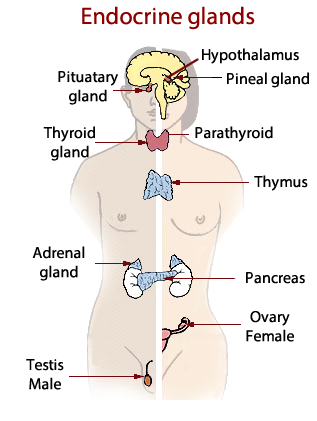
Adapted from By Governmenst [Public do teh main], via Wikimedia Commons
Glands and organs that affect the endocrine system
- Thyroid gland produces hormones that regulate metabolism, body temperature (heat related injuries), and bone growth. Thyroid-stimulating hormone (TSH or thyrotropin, thyrotropic hormone) is made in the pituitary and stimulates the thyroid gland to regulate the hormones produced in the thyroid. Triiodothyronine (T3), thyroxine (T4)which together regulate the use of energy and metabolism of almost every tissue in the body, and calcitonin that lowers blood calcium.
- Parathyroid glands produce hormones that balance calcium and phosphorus in the body.
- Ovaries produce hormones that regulate growth and produce egg cells for reproduction.
- Estrogen is produced in the ovaries and adrenal glands. It determines if cells use carbohydrates or fats for energy during intense exercise sessions. Women tend to burn fat for fuel because they have higher levels or estrogen, while men tend to burn carbohydrates.
- Testosterone contributes to muscle repair, building cells, and growth in both men and women. It is produced in the ovaries, testes, and adrenal gland. Intense exercise increases testosterone production.
- Testes produce hormones that regulate growth and produce sperm for reproduction.
- Testosterone contributes to muscle repair, building cells, and growth in both men and women. It is produced in the ovaries, testes, and adrenal gland. Requires intense exercise to increase production.
- Hypothalamus connects the endocrine system and nervous system. Stimulates the pituitary gland to release growth and development hormones. Regulates body homeostasis of temperature, heart rated, and blood pressure.
- Pineal gland secretes the hormone melatonin that regulates the sleep cycle and onset of puberty. More on sleep or read Snoozefest: The Surprising Science of Sleep
- Pituitary gland regulates and controls all endocrine glands.
- Anti-diuretic hormone (ADH) also called arginine vasopressin (AVP). It is made in the hypothalamus and stored in the pituitary. It signals the kidneys to regulate the amount of water in the blood stream. It also helps maintain blood pressure, constrict blood vessels (increasing ADH constricts blood vessels), regulate blood volume, and the concentration of urine excreted by the kidney.
- Endorphins are created in the pituitary gland. They make you feel exhilarated, happy, and block pain.
- Oxytocin - released by the pituitary gland in stressful situations. Urges you to seek others for support and help, anti inflammation, helps regenerate and strengthen heart cells. In women during birth it stimulates the contraction of the uterus and production of breast milk. It cements a bond between mother and child. Seems to increase social information processed in the brain.
- Adrenocorticotropic hormone (ACTH.) is produced in and released from the pituitary gland. It stimulates the production and secretion of cortisol (helps body manage stress) from the adrenal cortex. Its release is a responses to the release of corticotropin-releasing hormone (CRH), by the hypothalamus. Cortisol is necessary for life, so its levels in the blood must be closely controlled. When cortisol levels rise, ACTH levels normally fall. When cortisol levels fall, ACTH levels normally rise. Therefore, testing to measure the level of adrenocorticotropic hormone (ACTH) in the blood is used to monitor the health of the pituitary and adrenal glands.
- Thyroid-stimulating hormone (TSH, thyrotropin, thyrotropic hormone) is made in the pituitary and stimulates the thyroid gland. See thyroid gland.
- Growth hormone is a complex chain of amino acids secreted by your anterior pituitary gland. It is needed for muscle growth, collagen repair, joint health, immune system function, and healthy skin. Requires intense exercise and short rest intervals. Other Growth factors are similar to hormones and are also produced in the pituitary and most cells. Growth factors hepatocyte, fibroblast, and insulin like growth factor (IGF 1) sends signals to satellite cells to regulate the repair, rebuilding, and growth of muscle mass. IGF-1, for example, signals new muscle cells to fuse to existing muscle fibers to repair muscle cells damaged by exercise. Intense exercise and weight training can increase human growth factor by as much as 200%. Just be careful and have a spotter.
- Melanocyte-stimulating hormone (MSH) is a group of hormones produced by the pituitary gland, hypothalamus and skin cells. Melanocytes are cells in the basal (base) layer of the epidermis that produces melanin when signaled by MSH (melanocyte-stimulating hormone).
- Luteinizing hormone (LH) and follicle-stimulating hormone (FSH) are synthesized and secreted by the gonadotropic cells in the anterior pituitary gland. It is a gonadotropin, a glycoprotein polypeptide hormone and regulates development, growth, pubertal maturation, and stimulate the testes in males and ovaries in females which is necessary for reproductive. FSH stimulates the production of estrogen which stimulates egg cell production. LH causes ovulation and stimulates the ovarian cells to produce progesterone. LH stimulates the testes to produce testosterone. FSH controls the production of sperm.
- Prolactin stimulates production of milk in females after they give birth.
- Thymus gland regulates the immune system and produces T-cells.
- Adrenal glands produce hormones that regulate stress, salt and water balance. Secretions are from the adrenal cortex and adrenal medulla for emergency responses and other important functions.
- Adrenaline and noradrenaline also called epinephrine and norepinephrine are produced in the medulla. They regulate constriction of blood vessels (tension of blood vessels), heart rate, breathing, and metabolism (use of energy or use of glycogen and fat and muscle in the absence of sufficient sugar and fat). Sugar and fat are stored mostly in the liver and skeletal muscles, but also in smaller amounts in all other tissues and organs. The production or epinephrine and norepinephrine increases proportional to increased exercise intensity and duration.
- Norepinephrine is released into the blood stream from the medulla in the adrenal glands and in parts of the brain. It improves cognitive function dulled by stress by elevating mood and learning, whose production is increased with exercise. Exercise can make you smarter.
- Aldosterone is made in the adrenal cortex in the adrenal gland. It regulates sodium excretion important to maintain electrolyte balance.
- Cortisol is know as the chronic (long term) stress hormone, though there are others. The release of adrenocorticotropic hormone from the pituitary gland promotes the production and secretion of cortisol from the adrenal cortex. It maintains blood glucose for long periods of exercise by signaling the body to start breaking down proteins and triglycerides. Excessive physical activity and exercise without providing sufficient time to rest will increase cortisol, which is associated with inflammation, lowered immunity, reduced short-term memory, constipation, weight gain especially in the abdominal region, loss of muscle tone, osteoporosis, and reduced production of hormones: growth hormone, testosterone, DHEA and estrogen.
- Estrogen is produced in the ovaries and adrenal glands. It determines if carbohydrates or fat are used to fuel the body during an intense exercise session. Women tend to burn fat for fuel because they have higher levels or estrogen, while men tend to burn carbs.
- Pancreas provides functions for both digestive system and endocrine system. Hormones glucagon and insulin to regulate blood sugar (glucose) levels.
- Insulin is a hormone secreted by the pancreas and regulates blood sugar levels. More insulin decreases blood sugar faster. After a hard work out blood sugar is low and insulin levels high. To reduce insulin levels after a workout take simple sugars or simple proteins, such as dextrose and whey.
- Glucagon is a hormone that stimulates the liver to release glucose. Glucagon is released when blood glucose levels are low and more glucose is needed, such as with exercise and stressful situations. If too low it can cause the release of glycogen, a concentrated stored form of glucose stored in the liver and muscles. Insulin brakes it down into glucose for energy when blood glucose levels are low. Glycogen has an important role to fuel muscles during exercise. When we exercise, muscles will use their stored glycogen. When we rest the muscles replenish their glycogen stores in a few hours or in several days depending on the intensity of the work-out. When glycogen is used up, gluconeogenesis (the conversion of glucose from non carbohydrate substances, amino acids and fatty acids, in the liver and kidneys) begins. Turning stored fat (triglycerides and fatty acids) and muscle protein (amino acids) into glucose to use as fuel. This fat and protein metabolism is less efficient, so performance declines and fatigue occurs.
Other body areas that produce hormones or hormone like chemicals
- Neuroendocrine cells are cells that receive nerve inputs as nerves and release hormones like endocrine cells into the blood stream.
- Thyroxine, or T4, increases metabolism and hence caloric use during exercise. This will allow the body to burn excess sugar and fat faster. However, if you lack sufficient sugar or fat to burn, your body will begin to use muscle for energy and result in the lose muscle mass.
- Vasopressin is released by the brain and regulates the amount of water in the blood stream. Related to sweat when you exercise, staying hydrated, and urine production.
Endocrine system care
- Eat balanced meals and drink sufficient water
- Exercise
- Manage stress
- Get sufficient sleep (eight and one-half - nine hours a night) More on sleep or read Snoozefest: The Surprising Science of Sleep
- Avoid infections through proper care or medical treatment.
- Keep a balance of minerals or vitamins in your diet.
- Have regular medical check-ups
Endocrine health related issues
- Diabetes is caused by an imbalance of sugar in the body. There are two types: Type 1. and Type 2.
- Type 1: is when the pancreas doesn't produce enough insulin for the body to function well. The body requires insulin to use sugar (glucose) in or made from the food we eat. While insulin will reduce the amount of sugar in the bloodstream, injecting insulin is not a cure for diabetes. The body balances sugar levels in several ways. Through the types of food we eat, the amount of exercise we do, and the way our body produces and uses hormones that balance and control the use of glucose. A healthy pancreas makes and releases insulin and glucagon (hormones) to metabolize (use) glucose (sugar) for energy. Therefore, balanced insulin production controls blood sugar levels, so they do not get too high (hyperglycemia) or too low (hypoglycemia). Glucagon can also cause the liver to release glycogen, a concentrated form of glucose, which also effects glucose levels (see pancreas). Glucagon is injected to treat hypoglycemia (low sugar levels). Therefore, a healthy combination of these hormones must be found to balance sugar levels. To complicate finding a healthy combination is the variation of food intake and exercise that must be considered to determine not only the amount of insulin and glucagon needed, but the rate and time for them to be introduced. For example the fastest acting insulin on the market takes over an hour to reach peak effectiveness, while food will raise glucose levels within minutes. These combinations make it difficult to create an artificial pancreas or smart pump. Source
- Type 2 diabetes is when the pancreas produces insulin, but not enough for the body to function well based on the food and lifestyle choices made. The amount of insulin needed to process the amount of food eaten is out of balance. People may not know they have type 2 diabetes without a checkup or until the disease becomes severe.
- See also American Diabetes Association
- Thyroid problems related to too much or not enough production of the hormones it makes.
- Goiter often caused by lack of dietary iodine but if iodine is provided in table salt and other foods, then a goiter may also develo when the thyroid gland produces too much thyroid hormone (hyperthyroidism).
- Adrenal functions that make too much of its hormones.
Lymphatic system, Immune functions, & Inflammation data sheetReview
The lymphatic system includes a network of vessels that returns lymph fluid to the bloodstream, absorbs and transports fatty acids from the intestines to the bloodstream, and protects the body from unhealthy materials.
It detects unhealthy materials, among healthy tissue, and responds to remove them. Materials such as: wastes, toxins, pathogens (bacterias, viruses, parasites, cancer cells), damaged tissues, foreign objects, and combinations of these such as with (rusty nail and wood splinters).
One strategy to protect the body is to isolate the problem. Surround an infection or wound with fluid and materials to contain the problem (inflammation), kill any pathogen, remove dead tissue and foreign materials. Another way to isolate infections is with barriers between different parts of the body. Barriers between the brain (CNS), blood or vascular system, and gut (GI). See signaling inflammation across the gut brain barrier. Some supporting vocabulary: gastrointestinal tract (GI), afferent (gut to brain), efferent (brain to gut),gut vascular barrier (GVB), brain blood barrier (BBB).
The lymphatic system includes several kinds of immune cells, lymph fluid, lymph ducts, lymph nodes, the cardiovascular system, and organs: bone marrow, adenoids, tonsils, thymus, bronchus, bone marrow, intestine, appendix, spleen, and Peyer's patches.
The lymphatic system functions by producing immune cells that are transported in lymph fluid and the blood stream, and filter the lymph fluid and blood (spleen).
Lymph fluid is the liquid around the cells that contains water, protein, fat, and leukocyte cells deposited by the circulatory system. It is collected in the lymph ducts and moves to the heart.
Lymph nodes are small bean-shaped organs in the lymph ducts that filter pathogens and other harmful substances. They also contain immune cells that fight infection by attacking and destroying pathogens in the lymph fluid. See vaccination for how vaccines interact to create antibodies. vaccinationRoutes
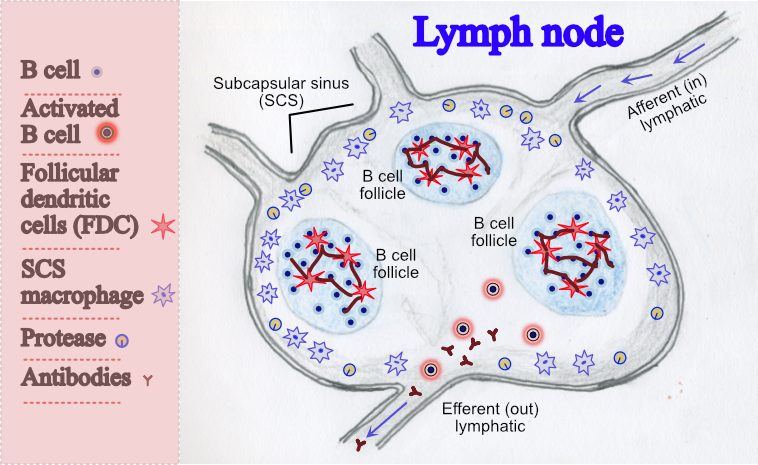
Lymph ducts are vessels made of muscle that expand and contract to move lymph fluid toward the heart. When it returns to the heart, it is remixed with the blood and recirculated to the body.
The immune function is a major function of the lympahtic system and connects to the circulatory, endocrine, and nervous system. It includes cells, tissues, and organs that work together to protect the body against disease causing agents, pathogens (bacteria, virus, parasites), and foreign substances that enter the body (toxins) and some cancer cells that develop within the body. It must respond quickly and efficiently as many pathogens rapidly evolve and adapt to avoid detection and the defensive actions of the immune system.
Lymphatic system diagram
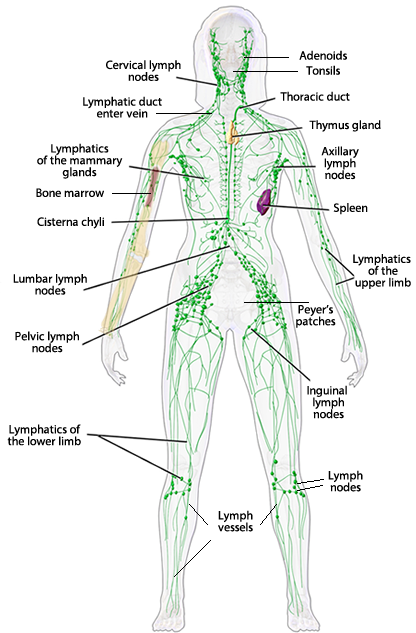
Adapted from Bruce Blaus "Blausen gallery 2014". [CC BY 3.0], via Wikimedia Commons
Organs
Tonsils and Adenoids help prevent throat and lung infections by reducing pathogens (bacteria and viruses) that enter the body through the throat and mouth with respiration. The tonsils and adenoids trap pathogens and kill them with antibodies (proteins) they make.
Thymus gland has glandular tissue and produces some hormones, related to the immune function, that promote, develop, and store white blood cells: T-cells (T-lymphocytes).
Spleen is a large secondary lymphoid organ where blood flows through it openly. It filters debris from the blood, recycles red blood cells and platelets, and stores leukocyte cells (white blood cells), T cells, and other antibody responses against blood borne pathogens. Like bacteria, that cause pneumonia and meningitis. Essential for the adaptive immune response are conventional dendritic cells (cDCs), located between the white and red pulp of the spleen. They capture antigens from the blood for T cells. How the cDC2s do this is not yet known.
Appendix protects the digestive system from infection and may serve as a reservoir for beneficial gut bacteria by stimulating growth of beneficial gut bacteria. The fetal appendix produces various biological control compounds that assist with various biological control (homeostatic) mechanisms. During early development the appendix functions as a lymphoid organ, assisting with the maturation of B lymphocytes and immunoglobulin A (IgA) antibodies.
Peyer's patches are small clumps of lymphatic tissue in the small intestine, but more concentrated in the ileum. They monitoring intestinal bacteria and preventing the growth of pathogen bacteria in the intestines.
Immune Cells
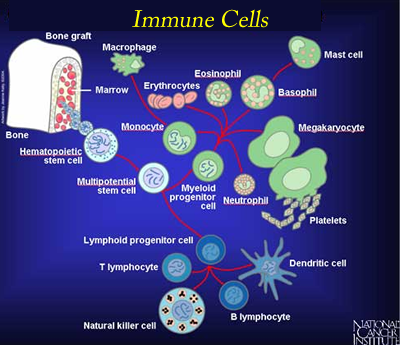 By Jeanne Kelly [Public domain or Public domain], via Wikimedia Commons
By Jeanne Kelly [Public domain or Public domain], via Wikimedia Commons
Antibody is a protein called an immunoglobulin, which binds to antigens or helps stop functions of pathogens through disrupting certain processes.
Leukocyte cells (some known as white blood cells) come in two types that combine to seek out and destroy disease causing organisms or substances in two ways: immediate nonadaptive and mediated adaptive.
Leukocyte cells include lymphocytes, neutrophils, basophils, eosinophils, monocytes, and macrophages. They are created by myeloid stem cells and provide innate immunity protection (protection that is quick and doesn't adapt). Myeloid stem cells also create erythrocytes, dendritic cells, and megakaryocytes (platelets).
Leukocyte cells in the lymph nodes trap and destroy pathogens (microorganisms that causes a disease). Leukocyte cells in the circulatory system are also part of the lymphatic system.
Lymphocytes, in the blood are leukocyte cells, which are crucial to our immune systems and work primarily with the lymphatic system. There are three main types known as T leukocyte cells (thymus gland), B leukocyte cells, and natural killer cells. Lymphocytes are part of our immune defense. Their purpose is to recognize antigens, produce antibodies, and destroy cells that could damage the body. See also Lymphatic and Immune systems.
Cells kill other cells by making holes in their membranes (shooting), oxidizing (burning), (in)activating multiple enzymes, and channels (poisoning).
T lymphocyte cells or T cells (thymus gland) and B lymphocyte cells (bone marrow) are a type of white blood cell and are natural killer cells that are part of our lymphatic defense. They recognize antigens, produce antibodies, and destroy cells that could damage the body. See lymphocytes video (4:56 ) See diagram for modifying T cells to treat disease.
MAIT (mucosal-associated invariant T) cells are abundant T cells that react against bacteria and viruses (microbiota - the microscopic organisms that inhabit the body). These lymphocytes respond to infections in the skin, mucos areas, liver, and tumors. They are beneficial for tissue repair and their affect on tumors is still being investigated. Their development seems to be influenced early in life by the environment an infant and the amount of B2 (riboflavin) available.
Th2 cells are in body fluids (as opposed to the cells) and activate and maintain antibody immune response against extracellular parasites, bacteria, allergens, and toxins to repair lymph vessels. Th2 will form and gather at damaged lymph vessels and create cytokines to stop lymphangiogenesis and promote connective tissue growth and fibrosis (scar tissue).
Neutrophils are the first defenders against microbe infection. Most often bacterial or fungal infection.
Basophils help with blood flow and prevent coagulation. They circulate in the bloodstream and release heparin (an anti-coagulant that prevents blood cells from clotting too quickly) and histamine released during allergic reactions to increase blood flow. Presence of these two molecules causes other immune system cells to arrive at an infection or inflammation.
Eosinophils defend against parasitic infections and allergic reactions.
Monocytes are made in bone marrow and develop into large macrophages in the bloodstream.
Macrophages are the largest of the leukocyte cells and engulf cell debris, waste, viruses, and harmful bacteria by extending pseudopodia (feet-like extensions) that surround and destroy the microbe by releasing enzymes.
Immune system care
- Eat a balanced diet
- Maintain a healthy weight
- Avoid illegal drug use
- Get regular medical check ups
Immune health related issues
- Allergic reactions are caused when foreign bodies (allergens) touch the skin or enter the body and cause an autoimmune response, that might not happen for most people. Symptoms, such as redness, rash, sneezing, itching, watery eyes, and a runny nose that result with the release of histamines in response to allergens.
- Autoimmune disease are conditions in which your immune system mistakenly damages healthy cells in your body. Types include rheumatoid arthritis, Crohn's disease, Lupis, and some thyroid conditions. See diagram for a new treatment using cells against cells.
- Hodgkin's disease or lymphoma is cancer in the lymph tissue in the lymph nodes, and spleen. Treatment can be removal of tissue, radiation, and chemotherapy.
- Immune deficiency is when the immune system is weakened to protect the body from infection. Causes can be congenital, poor nutrition of the baby's mother, hereditary, white cell production problem, HIV, chemotherapy, drug use, toxin ingestion, and aging.
- Lymphedema is when lymph fluid doesn't drain normally from a limb or other part of the body. Can result from cancer, tumors, or surgery when a lymph vessel is cut or blocks circulation.
- Tonsillitis is when pathogens cause an infected. Treatment with antibiotics or removal with surgery.
Inflammation
Inflammation is a process that balances (homeostasis) the functions between and within tissues and organs to maintain health and a process that protects the body from harmful environmental factors.
While the state of inflammation is always changing, it is mostly associated with more severe infection or injury, which can be identified with redness, swelling, heat, and pain.
However, inflammation ranges from minor changes, in the everyday homeostatic control process, to very serious responses that occur with tissue damage, often from injuries and infections. Which, can be caused by environmental (external) or internal actions.
Environmental causes of inflammation are: wounds, bacterial infections, viral infections, exposure to toxins (pollen, dust, chemicals, radiation), allergens, and parasites.
Internal causes of inflammation are: removal of dead cells, cancer, obesity, aging, and even sleep deprivation. More on sleep or read Snoozefest: The Surprising Science of Sleep
Combination of causes of inflammation are: starvation, dehydration, predation, envenomation (poison by biting or stinging) hypoxia, hypothermia, hyperthermia, and exposure to toxins.
Inflammation can lead to three types of problems: loss of regulation, loss of function, and loss of structure.
Inflammation is controlled by signals (cytokines chemokine, eicosanoids, and bioactive amines) to cells (macrophages, lymphocytes, monocytes, neutrophils, eosinophils, mast cells, and basophils, epithelial cells (goblet, Paneth cells) ) that trigger inflammatory actions or increase and decrease regular cell activities of: secretion, constricting, filtering, and barring entry. Actions to remove a foreign object and damaged tissue with actions such as peristalsis (muscle movement to move objects), diarrhea, vomiting, itching, sneezing, coughing, and increased mucus. If the action doesn’t eliminate the abnormal response, then inflammation can become acute and or chronic (continue after the initial problem is eliminated).
If the situation is eliminated, then anti-inflammatory signals are sent to reduce inflammation. Signals include IL-10, transforming growth factor β (TGF-β) and glucocorticoids. Other signals cytokine signaling (SOCS) proteins negative regulators of Janus kinase-signal transducer, and activator of transcription (JAK-STAT) signaling, and A20, a negative regulator of nuclear factor-kB (NF-kB) signaling.
An inflammatory response has to be strong enough to eliminate the original cause and remove any damaged tissue. However it can't be too strong as to damage too much tissue to fatally harm the organism. In other words the process must protect enough tissue to survive so neither the problem or solution becomes fatal. For example allergic reactions can produce enough histamine and leukotrienes to cause bronchoconstriction, which can kill a person. To avoid this, an injection of epinephrine is given to counter the effect by inducing bronchorelaxation to return to homeostasis.
While anti inflammatory drugs can provide benefit, they have side effects of increasing susceptibility to infections.
Details to the many processes of inflammation are still being discovered.
Sources
- Science Special section The spectrum of inflammatory responses. November 26, 2021.
- Tables and diagrams
Reproduction system Review
Reproductive system includes the sex organs required for procreation of offspring. It takes nine months for a human embryo to develop. Embryos are nourished by their mother. The substances a mother takes affects how well or poorly the baby develops. People are able to have children before they can care for them.
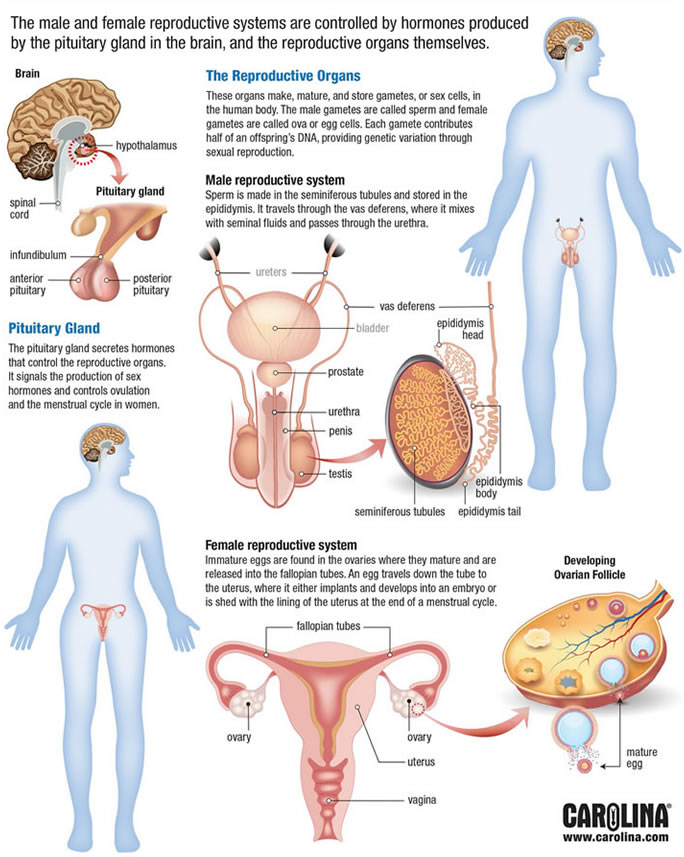
Reproductive system care
- Regular checkups and prenatal care.
- Eat a balanced diet
- Maintain a healthy weight
- Avoid the use of any substance that might lead to health problems
- Avoid illegal drug use
Word bank
Anorexia nervosa is a mental and physical disorder characterized by loss of weight brought on by an unrealistic fear of weight gain, self-starvation, and conspicuous distortion of body image. Health is compromised and may be fatal. Latin definition means - nervous inability to eat.
Anxiety is a feeling of unease, stress, or worry about what might happen.
Anxiety disorder is the most common mental disorder. It is the emotional feelings caused by real or imagined fears which are difficult to control and can cause a person to withdraw from activity, seek isolation, and develop physical illness, headaches, high blood pressure, and stomach disorders.
Find out about Auscultation - listening to body parts to diagnose health
Bulimia nervosa is a mental and physical disorder characterized by consumption of large amounts of food (binge) and ridding of the food and calories (purge) by fasting, excessive exercise, vomiting, or using laxatives. The behavior often serves to reduce stress and relieve anxiety created by concern with weight and self-image. It is often accompanied by depression, is serious and sometimes life-threatening.
Cells is the smallest living thing or the smallest structure that functions as one part of an organism. Usually microscopic with cytoplasm and a nucleus inside a membrane. There are hundrends of cells. Some include: Stem cells, red blood cells (erythrocytes), white blood cells (leukocyte cells), platelets, nerve cells (neurons) muscle cells (myocytes), cartilage cells (chondrocytes), bone cells, skin cells (endothelial & epithelial), fat cells (adipocytes), sex cells (gametes).
Circulatory or cardiovascular system includes the heart that circulates blood 24 hours a day to and from the cells through the arteries and veins. The blood transports gases, nutrients, waste products, white blood cells (leukocyte cells), hormones, and chemicals as a response to the bodies needs.
Digestive system includes the mechanical and chemical processes that break down food, into molecules, so it can be absorbed from the digestive tract into the blood stream and distributed to the cells.
Eating disorders. Hunger activates brain responses that motivate eating. However, people with anorexia, bulimia nervosa, and other eating disorders brain circuits are less active after fasting. Their brains could identify being hungry, but their brain did not signal a desire to eat.
Excretory system eliminates undigested food and waste (solid, liquid, & gas) from the body so it can live.
Endocrine system includes chemicals (hormones) secreted by endocrine glands: adrenal, pineal, ovary, testis directly into the blood stream. They signal and regulate physical and mental body functions.
Human anatomy is the study of the human body and its functions.
Human body is all the physical stuff that makes a human being. Cells that create tissues, tissues that create organs, and organs that create systems.
Immune system is associated with the immune system and leukocyte cells that defend against disease.
Lymphatic system is associated with the lymphatic systemand leukocyte cells that defend against disease.
Muscular system enable the body to move, voluntarily (aware: walk, move ... ) and involuntarily (unaware: heart beat, digest food, breathe ... ), offers protection, and body form and shape.
Nervous system coordinates all of the bodies activities with the brain, nerves, and spinal cord.
Organ is a group of cells or tissues inside an organism that works together for a special purpose.
Reproductive system includes the sex organs required for procreation of offspring.
Respiratory system moves air into the lungs through the nose, mouth, and the trachea. The lungs remove oxygen from the air to metabolize food and provide energy to move muscles, repair cells, feed brains, calm nerves, and clean the body of toxins.
Skeletal system includes 206 bones, which are living tissues and connective tissues: ligaments that attach bone to bone, cartilage that cushion bones and tendons that attach muscle to bone.
Skin (Integumentary) system is the covering of the body.
Systemis an organized group of tissues that have a particular function.
Tissue is a substance made from a group of cells that function together for a particular purpose.
Accurate and quality information is needed to make good healthy decisions.
A healthy person understanding what is human, their body, it's anatomy, functions of life, growth, and development well enough to care for them self and others to attain and maintain physically, emotionally, and socially healthy bodies. To achieve this one must be able to describe, analyze, predict, and compare how different variables affect the body to make wise decisions. Desire to learn about nutrition, diet, exercise, sleep, stress, relaxation, choice of behaviors, social skills, conflict resolution, cooperation, genetics, safety, injuries, health status, illness, natural disasters, environmental health, and risks, will impact them and others in different situations or conditions.
More on sleep or read Snoozefest: The Surprising Science of Sleep
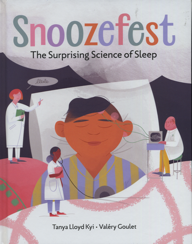
References
- Cell activities
- Find out about Auscultation - listening to body parts to diagnose health
- Investigations